
THE WARBLERS OF WESTBY

Amazing bird sightings in northeastern Montana

IN THIS ISSUE:
BLACK BEARS GET THEIR DUE INTO THE SNOWPACK “BASEMENT”
CONSERVING OUR EASTERN WESTSLOPES
THANKING BLOCK MANAGEMENT COOPERATORS
INSIDE: SHOCKING NEWS ABOUT STREAM SURVEYS
FISH, WILDLIFE & PARKS | $4.50 MARCH–APRIL 2024
MONTANA

MONTANA OUTDOORS
VOLUME 55, NUMBER 2
STATE OF MONTANA
Greg Gianforte, Governor
MONTANA FISH, WILDLIFE & PARKS
Dustin Temple, Director
FIRST PLACE MAGAZINE:
2005, 2006, 2008, 2011, 2017, 2018, 2021, 2022
Association for Conservation Information
MONTANA OUTDOORS STAFF
Tom Dickson, Editor
Luke Duran, Art Director
Angie Howell, Circulation Manager
MONTANA FISH AND WILDLIFE COMMISSION
Lesley Robinson, Chair
Susan Brooke
Jeff Burrows
Patrick Tabor Brian Cebull
William Lane K.C. Walsh
MONTANA STATE PARKS AND RECREATION BOARD
Russ Kipp, Chair
Jody Loomis
John Marancik
Kathy McLane
Liz Whiting
Montana Outdoors (ISSN 0027-0016) is published bimonthly by Montana Fish, Wildlife & Parks in partnership with our subscribers. Subscription rates are $15 for one year, $25 for two years, and $30 for three years. (Please add $3 per year for Canadian subscriptions. All other foreign subscriptions, airmail only, are $50 for one year.) Individual copies and back issues cost $5.50 each (includes postage). Although Montana Outdoors is copyrighted, permission to reprint articles is available by writing our office or phoning us at (406) 495-3257. All correspondence should be addressed to: Montana Outdoors, Montana Fish, Wildlife & Parks, 930 West Custer Avenue, P O. Box 200701, Helena, MT 59620-0701. Website: fwp.mt.gov/montana-outdoors. Email: montanaoutdoors@ mt.gov. ©2024, Montana Fish, Wildlife & Parks. All rights reserved.
For address changes or subscription information call 800-678-6668 In Canada call 1+ 406-495-3257
Postmaster: Send address changes to Montana Outdoors, Montana Fish, Wildlife & Parks, P O. Box 200701, Helena, MT 59620-0701. Preferred periodicals postage paid at Helena, MT 59601, and additional mailing offices.
CONTENTS

MARCH–APRIL 2024
FEATURES
12 Giving Thanks In February At Block Management cooperators’ dinners each winter, hunters and FWP staff show their gratitude to landowners for providing access and habitat.
By Andrew McKean. Photos by Sean R. Heavey
16 What’s Up Down There? By regularly monitoring fish populations, FWP crews gather information essential for managing and conserving Montana’s world-renowned sport fisheries and imperiled native species. By Paul Queneau
26 Below The Snow The world of wildlife beneath the white surface of winter. By
Ellen Horowitz
34 A Lifelister’s Paradise Every dedicated Montana birder needs to migrate to the Westby area for a few days in springtime.
By Sneed B. Collard III
36 Saving Montana’s Prairie Trout FWP biologists fight rainbow trout hybridization to save westslope cutthroat east of the Continental Divide from local extinction. By E. Donnall Thomas, Jr.
42 So That’s Where They Go New Motus technology helps biologists learn where birds, small mammals, and even butterflies travel throughout the year. By Sneed B. Collard III
ON THE PROWL A coyote sniffs a vole beneath the snow surface. See page 26 to see what other wildlife is living down there in the subnivean zone. Photo by Donald M. Jones.
MONTANA OUTDOORS | MARCH–APRIL 2024 | 1 2 LETTERS 3 TASTING MONTANA 4 OUR POINT OF VIEW 5 FWP AT WORK 6 SNAPSHOT 8 OUTDOORS REPORT 10 FWP SOCIAL MEDIA SHOWCASE 10 LOOKALIKES 11 INVASIVE SPECIES SPOTLIGHT 11 THE MICRO MANAGER 48 SKETCHBOOK 49 OUTDOORS PORTRAIT DEPARTMENTS
COVER Blackburnian warblers are just one of more than a dozen bird species rarely seen elsewhere in Montana that stop in the tiny town of Westby during spring and fall migrations. Photo by Francis Philippe.
LETTERS
Meadows need more fire, fewer invasives
Your article “More Mountain Meadows” (November-December 2023) highlighted the essential need to create considerably more vegetation conducive to summer habitat for elk, mule deer, moose, and other wildlife on public lands. Century-old photos show that much of Montana’s forested public lands were much more open. They are now thickly tree covered, due largely to fire suppression. Allowing wildfire to play its natural role is the only viable way to create former amounts of big game summer habitat on much of our national forest land where timber harvest is not feasible.
Greg Munther Missoula
Your interesting article “More Mountain Meadows” neglected to mention the problem of noxious weeds. Where I live just below the Continental Divide in Lewis and Clark County, most meadows near logged areas are thick with knapweed and houndstongue, neither of which are palatable to wild ungulates. Revitalizing mountain meadows might require more weed spraying.
Joane Bayer Canyon Creek
Credit where it’s due
The article “Wolverine Watcher” (November-December 2023) failed to mention that Don Heffington’s approach to monitoring wolverines and Canada lynx, while important and commendable, was originally developed by Alaska Department of Fish and Game wolverine biologist Dr. Audrey Magoun in 2011. In addition, my partner, Kalon Baughan, who supplied wolverine photos for your article, has been building on Magoun’s work with his own research over the past 12 years


in Montana. Kalon introduced Don to his frame set design, an adaptation of Dr. Magoun’s original work tailored to suit Montana’s wolverine habitats. Thanks so much for all you do at Montana Outdoors, which Kalon and I both highly value, and for the opportunity to share this feedback.
Katie Meiklejohn Helmville
Best issue
I have been a subscriber to Montana Outdoors for two decades. I think the November-December 2023 issue is the best issue ever. Great articles and awesome photos. Keep it up.
John Backs St. Ignatius
Another best
I have been a subscriber for some time now and love this magazine. Your recent 43rd annual photo issue is profoundly the best collection of true wildlife photos I have ever seen, stirring emotions I didn’t know I possessed. My hat is off to all who take part in the production of Montana Outdoors. Happy holidays to all and thank you for making an old man smile.
Nick Brown Little Falls, NJ
Learning the language
I read with interest your essay on not knowing agricultural jargon (“A working-lands ignoramus,” September-October 2023). It is always interesting and humorous to learn of another discipline’s
terminology. I came to Montana State University over 50 years ago to accept a research assistantship studying winter wheat nitrogen fertilization. Fortunately, I was raised on a farm in Oklahoma, so I had no trouble communicating.
Grant Jackson
Professor of Agronomy, Emeritus, Montana Agricultural Experiment Station, Bozeman
Regarding your interesting essay on “working lands,” I’d like to note that in addition to farmers and ranchers, there are mechanics, plumbers, sheet rockers, office workers, and lots of other men and women whose important jobs don’t get the attention they deserve.
Kevin Kennedy Federal Way, WA
I appreciated your candid Sketchbook “ignoramus” essay. Interesting how we all basically come to know mainly what we have been surrounded with and have to wonder about the rest. I grew up on a farm but probably missed out on much city slang.
Rick Nelson
Steilacoom, WA
Too much
The cost for my nonresident combination big game license last year was $1,382.70. Ugh!
I started making my hunting trips to Montana from Michigan in 1973. I haul horses in a horse trailer 1,640 miles to your state. I’ve had many good adventures and hunts, as well as my share of bad hunts. Over the past 50 years, I’ve introduced 71 different people to hunting in Montana, including my sons, their friends, and other relatives. All of us have spent, by my estimate, hundreds of thousands of dollars on motels,
licenses, restaurants, feed for the horses we bring, sporting goods stores, groceries, and more.
But $1,382.40 for a license is getting to be too much.
I get it. I should have moved to Montana, but that wasn’t possible because of my career and raising a family. What worries me most about the high cost of nonresident licenses is that it is making hunting a sport only for the very rich. That’s not the way it’s supposed to be.
Gary Brown Conklin, MI
Corrections
Idahoans pointed out that the Potato State indeed does have a stream access law similar to Montana’s. We mistakenly stated otherwise in the November-December 2023 Director’s Message (“Supporting stream access”).
The article “More Mountain Meadows” stated that the Lolo National Forest’s management plan was in draft form. It now has been finalized and was released in late January 2024.
Also in that issue, our article “Mountain Peaks in a Prairie Sea” included a map showing the Highwood Mountains as south of Great Falls when they are actually about 20 miles due east. And the article “Do the Right Thing” (September-October 2023) mistakenly stated that Oregon has banned black bear and mountain lion hunting, which our Oregonian subscribers tell us is still legal there (though not with hounds or baiting). n
Speak your mind
We welcome all your comments, questions, and letters to the editor. We edit letters to meet our needs for accuracy, style, and length. Write to us at Montana Outdoors, P.O. Box 200701, Helena, MT 59620-0701. Or email us at: tdickson@mt.gov.
2 | MONTANA OUTDOORS | MARCH–APRIL 2024
Venison Steak au Poivre with Red Wine Sauce
By Tom Dickson I
Preparation time: 30 minutes I Cooking time: 10 minutes I Yield: 4 servings

Why do the dishes served in fine restaurants taste so good? One reason is that highly trained chefs have years of experience. It’s like any profession, where the experts usually do a better job than the amateurs—in this case, us home cooks.
Top chefs also use fresh ingredients, make their sauces and broths from scratch, and add much more butter, cream, and salt than most of us do.
Finally, there’s presentation. Top food establishments pay nearly as much attention to how a dish looks on the plate—arrangement, color, texture—as they do to how it tastes. If a dish appears delicious, the odds are much better that the customer will find it so.
Those of us working to improve our game cooking skills can take a page from the professionals: Add a bit more salt, butter, and cream (on special occasions for special dishes), spend the time to make more elements from scratch, and try to emulate the beautiful images featured in cookbooks and on websites.
The two recipes here are fairly easy to make and produce those luscious flavors so regularly found at high-end restaurants. n
—Tom Dickson is the Montana Outdoors editor.
Braised Leeks and Carrots (Zeytinyağlı Pırasa)
This elegant Turkish side dish is a delicious accompaniment to any type of wild game, especially venison. Heat ¼ c. olive oil over medium-high heat in a saucepan until shimmering. Add 3 large, cleaned leeks (keep only the white and light green section) and 2 to 3 carrots, all cut into ¼-inch rounds beforehand. Add 3 minced garlic cloves. Season with kosher salt, black pepper, 1 t. ground cumin, and 1 t. ancho chili powder or paprika. Cook for 5 to 7 minutes, until the vegetables begin to soften, stirring regularly.

INGREDIENTS
1½ lbs. venison loin or other steaks (4–6 small steaks about 1-inch thick)
Salt
2 garlic cloves, smashed to a paste
½ t. coriander seeds, lightly toasted and ground, or pre-ground
½ t. fennel seeds, lightly toasted and ground, or pre-ground
2 t. coarsely crushed black peppercorns, or pre-ground
2 T. olive oil
1 T. butter
2 shallots, minced ½ c. red wine
2 c. chicken or beef broth (homemade if possible)
2 T. butter
DIRECTIONS
Season steaks with salt. Sprinkle with garlic, coriander, fennel, and black pepper. Drizzle with olive oil. Rub to coat evenly with spices on both sides. Let marinate at room temperature for 15 minutes (or refrigerate for up to 4 hours and bring to room temperature before cooking).
Make the red wine sauce: Melt 1 T. butter over medium-high heat and add shallots. Cook, stirring, until lightly browned, about 2 minutes. Add wine and simmer until reduced by half. Add broth and reduce until 1 cup sauce remains, about 10 minutes. Turn off heat and swirl in remaining butter to thicken. Season with salt, set aside and keep warm.
Set a wide cast-iron skillet over mediumhigh heat (or use 2 smaller pans). When hot, lay in steaks and sear for 2 minutes, until nicely browned. Flip and cook 1 minute more for rare, 2 minutes for medium rare. Arrange steaks on a platter or individual plates. Spoon wine sauce over each steak. Serve with mashed potatoes or French or steak fries. n
More recipes from Montana Outdoors
MONTANA OUTDOORS | MARCH–APRIL 2024 | 3 TASTING MONTANA
PHOTOS: SHUTTERSTOCK
What are you seeing out there?
Here at FWP, we want to know what hunters, landowners, and others see and experience during their time outdoors. Along with our own scientific surveys, that information helps us manage the state’s fish and wildlife with the most complete and current data available.
For instance, in the past few years we’ve cut way back on mule deer B (antlerless) licenses in many hunting districts across the state. Our observations of reduced deer numbers had been confirmed by those of farmers, ranchers, hunters, and outfitters, who wanted to decrease the harvest even further. At its December 2023 meeting, the Montana Fish and Wildlife Commission—representing the public—responded by eliminating antlerless mule deer harvest on public land throughout Regions 6 and 7 in eastern Montana for the 2024 season.
Listening to what people observe outdoors can inform and reinforce our biologists’ own observations and population trend estimates. But what if what hunters, landowners, and others are seeing doesn’t align with our scientific surveys? That happens. Sometimes, for instance, we may not observe many deer or elk during spring aerial surveys, yet the public tells us they are seeing a lot. Or vice versa.
Either way, we’d want to understand the reason for the discrepancy. Were we flying during a week when weather caused deer or elk to behave abnormally, showing themselves less or more than usual? Were other factors at play?
Our biologists use state-of-the-ar t science to monitor wildlife, but Montana’s weather, especially, can confound even the best methodologies and technologies. Hearing from you lets us know that we may need to go back and do some fine tuning.
How do we know what mule deer hunters and others see and want? We ask with surveys, and we listen when people call, send emails, come into our offices, and show up at public meetings. During the process of creating the management plans that guide our work, we provide the public with opportunities to voice their concerns and comment on draft documents. For instance, as we’ve started the process to develop a new mule deer management plan this year, we’re asking the public to tell us their expectations for mule deer management. To better understand landowner concerns about wildlife and other matters, we’ve increased the number of staff attending agricultural conventions.
We are also listening and responding to other concerns, such as adjusting our upland game bird regulations to keep pace with growing numbers of hunters from outside Montana, figuring out how best to protect trout populations in southwestern Montana, and establishing new rules for grizzly bear management.
How do we know what mule deer hunters and others see and want? We ask with surveys, and we listen when people come into our offices and show up at public meetings.

Though we try to be responsive, sometimes we’re asked to do things beyond our authority, such as limit seasons and raise license fees for nonresident hunters, increase fines for trespassing, or prevent private landowners from outfitting. In those cases, decisions would be up to the Montana Legislature, not FWP.
Balancing science with public perception is one of the great challenges of managing Montana’s fish and wildlife. FWP is a science-based organization that relies on solid data and thorough research. It would be irresponsible to ignore what the science tells us. But at the same time, we value the insights of the thousands of hunters, anglers, landowners, hikers, and others out there on the ground each day.
If we determine that a fish or wildlife population seems healthy based on the science we’re using, but you think otherwise based on your own observations and experience, we want to hear from you. That way we can ground-check what we’re doing and make sure that the decisions we make are backed by good science as well as what Montanans are seeing for themselves.
Dustin Temple Director, Montana Fish, Wildlife & Parks
DONALD M. JONES
4 | MONTANA OUTDOORS | MARCH–APRIL 2024
OUR POINT OF VIEW
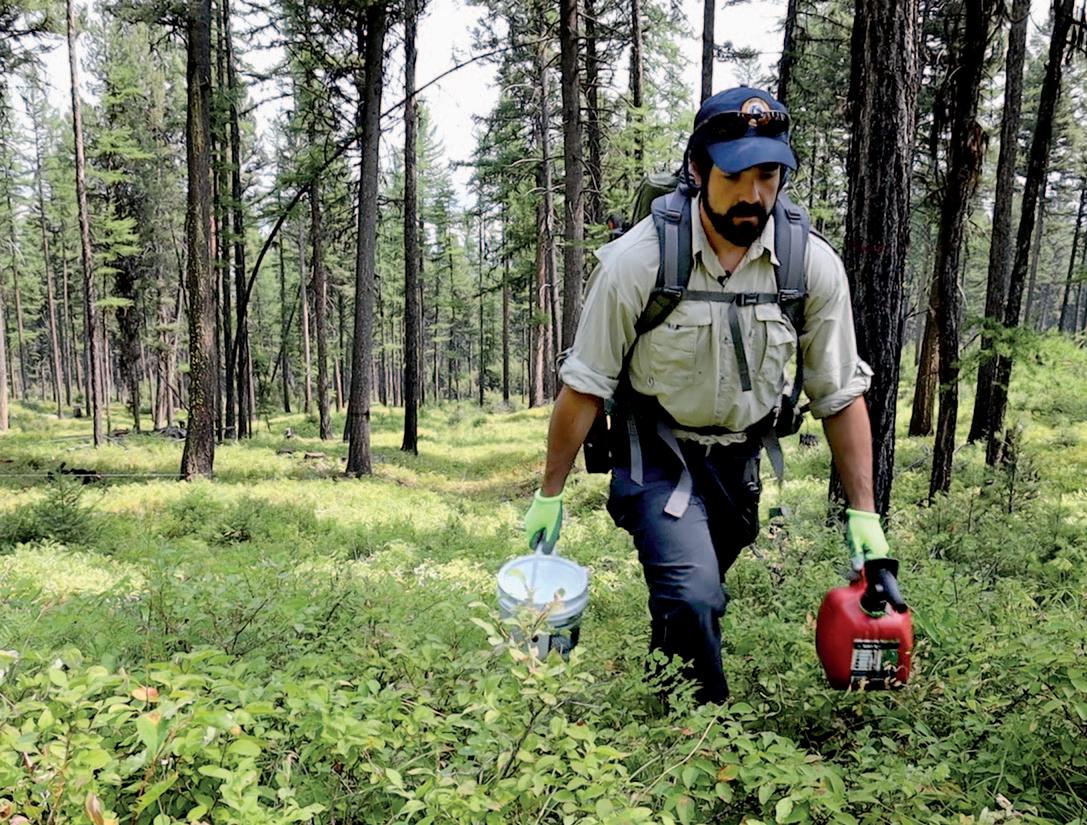
MR. BLOOD AND GUTS
I GREW UP AND EARNED MY undergraduate and doctorate degrees in California—but don’t hold that against me! I moved out here in 2009 to work as a wildlife technician on a wolf research project. I later did my PhD dissertation on estimating the cougar population and predatory behaviors of cougars and wolves in northern Yellowstone National Park.
I’ve also studied black bears and mountain lions in Colorado, black bears in California, and grizzly bears in Alaska. I spent two years working with the Montana Cooperative Wildlife Research Unit at the University of Montana on mule deer and moose projects.
After the Missoula position, I wanted to run a program that estimated regional black bear populations similar to what I’d done with cougars in Yellowstone. I lucked out when FWP announced it wanted to model a new black bear population monitoring program on the one it uses for mountain lions. The department wants to get a better idea of bear numbers and abundance across the state beyond what’s learned from annual harvest data.
COLBY ANTON Black Bear Monitoring Biologist, Missoula
Our first field season was 2023, when we set up dozens of barbed wire corrals in the Blackfoot River drainage. In each corral, we poured fermented cow’s blood and fish guts on a pile of dead wood to lure the bears so we could get hair samples from the barbs. That stinky stuff is what I’m carrying in the bucket and gas can in the photo above, taken near Greenough.
By setting up hundreds of these stations over the next few years and doing DNA analysis on bear hair samples, we’ll be able to determine regional populations and abundance and eventually gain greater insight into the statewide population. We also began radio-collaring male and female black bears to learn where they travel and den in winter, as well as survival rates, reproductive success of females, and other essential information.
Ultimately the goal of all this work is to provide wildlife managers with the data they need to maintain hunting opportunities and other management tools for sustaining healthy black bear populations in Montana.
MONTANA OUTDOORS | MARCH–APRIL 2024 | 5 FWP AT WORK
LAUREN KARNOPP/MONTANA FWP
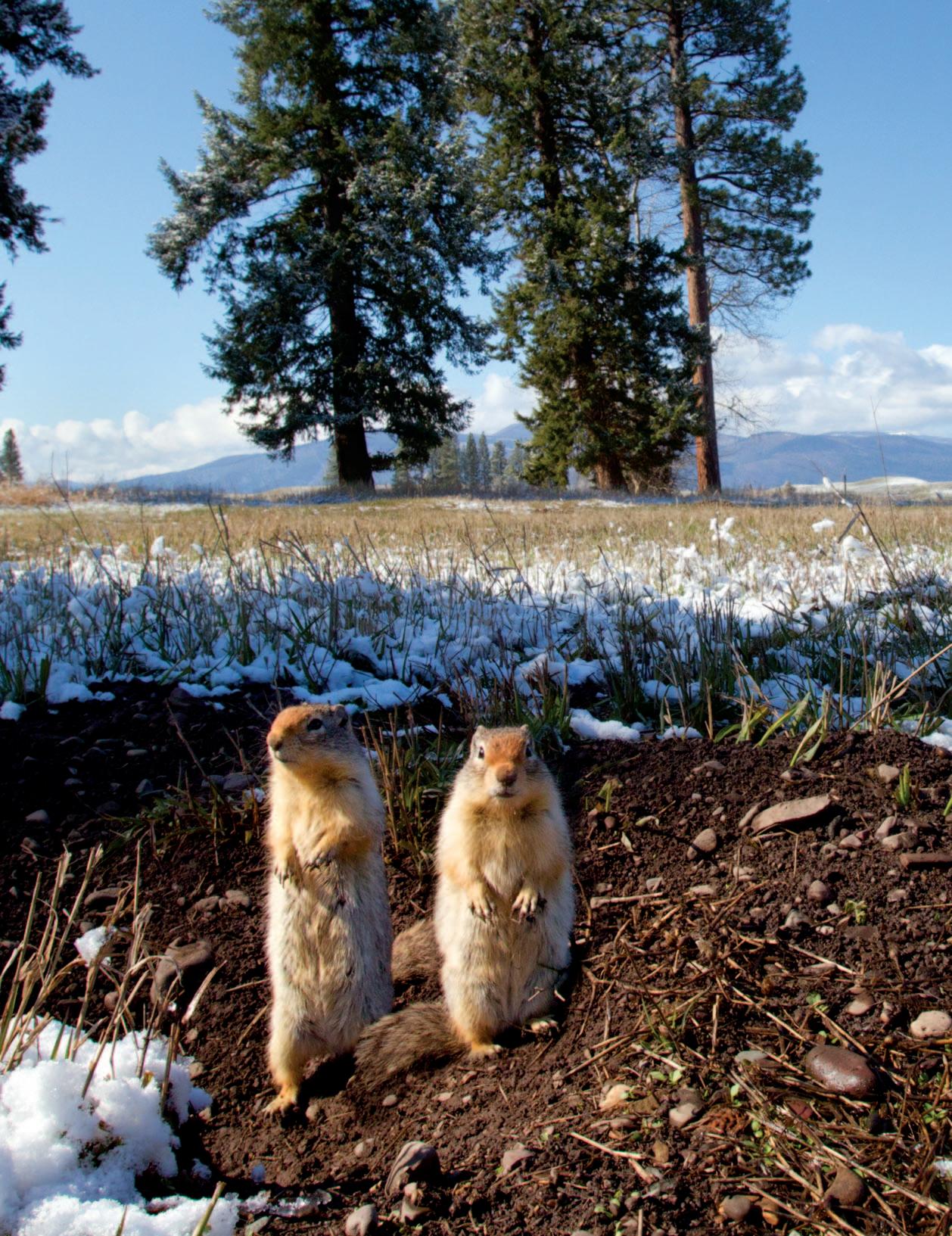
6 | MONTANA OUTDOORS | MARCH–APRIL 2024 SNAPSHOT

Alex Badyaev was conducting wildlife research in the Blackfoot Valley several years ago when he spied a colony of Columbian ground squirrels. He set his camera with a wide-angle lens on the ground with a remote shutter to capture the rodents’ perspective of a classic agricultural setting. “I wanted the viewers to see what these squirrels’ world was like in spring, when they are emerging from their burrows and interacting with each other again,” he says.
Dr. Badyaev, a professor of evolutionary biology at the University of Arizona who studies wildlife in Montana throughout the year, says that including a familiar human element in the photo, such as a barn, invites viewers into the image. “I want something they can relate to that gives them an entry point into the story that the photograph tells.” n
MONTANA OUTDOORS | MARCH–APRIL 2024 | 7

Number, in thousands, of visitors, program participants, and elementary school students who visited FWP’s Montana WILD Education Center in 2023.
Have great horned owlets already hatched?
Though it’s still winter, some great horned owl hatchlings may already be stirring in their nests. That’s because great horned owls are Montana’s earliest birds to mate and lay eggs.
Great horned owls may begin courting as early as January, when males hoot vigorously to attract females. Two birds that like each other copulate and the female lays one to four eggs in an abandoned raven or red-tailed hawk nest. In western Montana, this usually occurs in February.
After about five weeks, the eggs hatch, but then it takes another 10 weeks or so before the young owls can take flight and begin hunting on their own.
Great horned owls mate early in the year so that their slow-developing young have enough time during summer and fall to hunt and build strength for the winter ahead. n


Don’t pet the porcupette
It’s almost spring, and soon baby animals will be waddling, stumbling, swimming, flapping, and frolicking throughout Montana. Here are the common names of those little cuties. And remember: Leave seemingly orphaned young animals alone. The mother is likely nearby trying to eat and could abandon its baby if you touch it.
fawn: deer, pronghorn
calf: elk, moose
lamb: bighorn sheep
kid: mountain goat
cub: bear
porcupette: porcupine
kitten: mountain lion, bobcat, lynx
pup: wolf, coyote, otter, mouse, vole, shrew, prairie dog, bat, mole, squirrel
kit: fox, beaver, rabbit, weasel
bunny: rabbit
leveret: hare
hatchling: birds that have just hatched nestling: baby birds still in their nest
fledgling: young birds that have left their nest
chick: most baby birds
squab: rock pigeon
eaglet: eagle
owlet: owl
colt: sandhill crane cygnet: swan gosling: goose duckling: duck
poult: wild turkey tadpole, pollywog: frog, toad
snakelet: snake larvae, fry, fingerling: all fish
parr, smolt: trout
OUTDOORS REPORT
28 8 | MONTANA OUTDOORS | MARCH–APRIL 2024
NOMENCLATURE
CLOCKWISE FROM TOP LEFT: MIKE MORAN ILLUSTRATION; BECCA WOOD; SHUTTERSTOCK
A baby porcupine near Sheridan
FWP releases new videos on river recreation ethics
Rafting, boating, fishing, and kayaking are among the most popular outdoor activities in Montana. But increasingly, people out on the water are not recreating with what FWP officials have dubbed the “Montana Mindset.”
“By that we mean following the traditional Montana way of being safe and being respectful to others and the resource,” says Greg Lemon, head of the FWP Communication and Education Division.
To help boaters and others understand and practice the right behaviors, FWP and other agencies and organizations recently created three videos demonstrating what to do when out enjoying Montana’s renowned rivers.
FWP partners for the videos include the Flathead National Forest, Bureau of Land Management, Flathead Rivers Alliance, River Management Society, and Montana PBS.
“The videos are the first step of a larger
effort to encourage better behavior by everyone recreating on all public lands and waters,” says Lemon. “This and other Montana Mindset messaging emphasizes outdoor recreation ethics and etiquette that we hope will result in better outdoor experiences for everyone. The messages also address public safety and environmental effects on the outdoors, like the spread of aquatic invasive species.”
The new river videos are titled “Preparing for a Montana River Float,” “Montana River Recreation Safety,” and “Montana Overnight River Recreation Tips.” All three include stunning footage of the Smith, Blackfoot, South Fork of the Flathead, and other scenic Montana rivers.
View the new videos here.
Look for other Montana Mindset guidelines throughout 2024 on FWP’s and partner organizations’ websites and social media channels. n
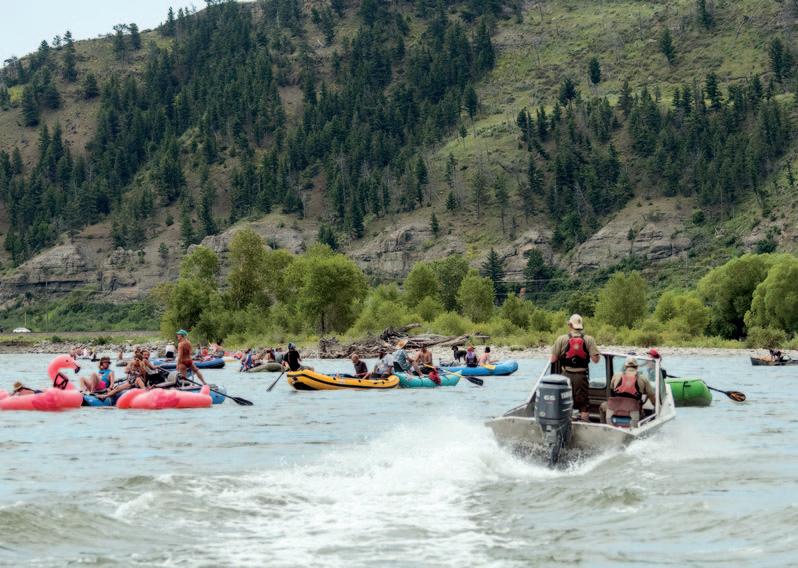

AIS crews find infested boats
FWP’s Aquatic Invasive Species (AIS) Program recently released results from the 2023 boating season:
Watercraft inspections
u 130,000 watercraft were inspected at AIS inspection stations.
u 53 watercraft carrying invasive mussels were intercepted and decontaminated.
u 600 boats carrying aquatic weeds were intercepted and decontaminated.
Early detections
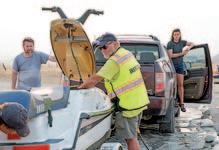
u AIS crews collected 3,000 samples from lakes, rivers, and reservoirs across Montana.
u Analysis of the samples showed no evidence of invasive mussels.
u New infestations of New Zealand mudsnails were detected in the upper Clark Fork basin in Silver Bow Creek below Warm Springs Ponds.
u Curlyleaf pondweed was detected in the Missoula Kids Pond and in a subdivision pond in Bozeman.
u Eurasian watermilfoil was detected in Thompson Park Pond next to Noxon Reservoir.

AIS watercraft inspection stations will reopen in March 2024, and the surveys and sampling will start again in the spring. n
MONTANA OUTDOORS | MARCH–APRIL 2024 | 9 OUTDOORS REPORT CLOCKWISE FROM TOP RIGHT: THOM BRIDGE; JOHN WARNER; THOM
WARNER
BRIDGE; JOHN
RECREATION
FWP game wardens patrol the water downstream from Four Banger Rapids near Big Timber. The rapids are among the largest on the lower Yellowstone River and the epicenter of the annual floating booze fest known as the Yellowstone Boat Float. Unsafe and unethical behavior abounds.
FWP SOCIAL MEDIA SHOWCASE
Recent postings produced by FWP staff for Facebook and YouTube

Returning sharpies to western Montana
Join FWP biologist Kristina Harkins as she explains how sharp-tailed grouse advocates are helping bring the prairie bird back across the Continental Divide.
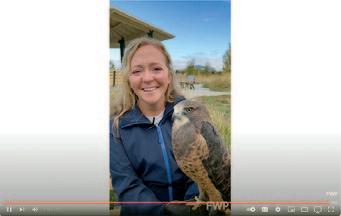
A close look at Swainson’s hawks
FWP education specialist Corie Bowditch gets up close with one of these large raptors, which each fall travel more than 6,000 miles to their wintering grounds in Argentina.

Barking at bears
FWP videographer Lauren Karnopp tells how one ranching family is using livestock-protection dogs to keep grizzlies away from their cattle and hogs.
LOOKALIKES
Tips for differentiating similar-looking species
Though fishing guides and longtime trout anglers can easily tell these two non-native species apart, some visiting anglers and resident beginners struggle. One challenge is that the fish’s colors can be different depending on the water where they live and the time of year. Coloration shown here is for most waters in midsummer. n
Body
Spots
Larger haloed dark spots from the head to the tail. Spots always on the upper and sometimes lower part of the tail.
Red spots
Some haloed red spots on body.
Olive upper half and a broad pink lateral stripe along silvery sides.
Cheek Pink cheek cover.
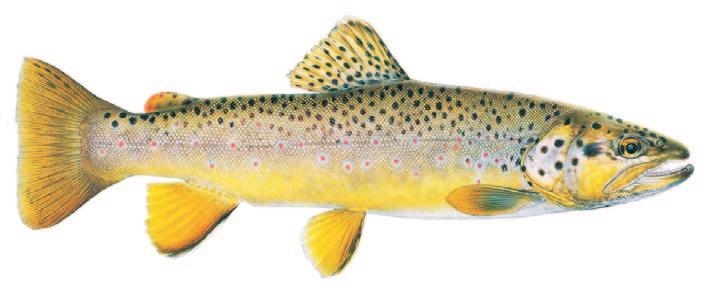
RAINBOW TROUT
Oncorhynchus mykiss

Spots
Small dark spots across the body from the head through the tail. No red spots.
Body Yellow to orange belly; light brown, cream, or silvery sides; cream-olive top. No pink anywhere.
Tail Spots throughout the tail are small and in distinct rows.
JOSEPH TOMELLERI
BROWN TROUT
Salmo trutta
10 | MONTANA OUTDOORS | MARCH–APRIL 2024
INVASIVE SPECIES SPOTLIGHT
Emerald ash borer
What it is
Native to Asia and Russia, the emerald ash borer is a destructive wood-boring insect that has killed nearly 100 million ash trees across the Midwest and eastern Nor th America. So far it has not reached Montana, but because the insect can travel in firewood, it could easily show up in a load transported from another state. How to ID it
The ash borer is a half-inch-long metallic-green adult beetle with a red abdomen. Its presence can be indicated by D-shaped boreholes in ash tree bark.
Where it’s found
Emerald ash borers were first discovered in Michigan in 2002. Since then they have spread to 35 states, becoming the most destructive invasive wood-boring insect in U.S. history. The closest ones to us are in southeastern South Dakota and Denver, Colorado.
How it spreads
The main way this insect travels is via transported firewood. Fortunately, extreme cold temperatures in the Midwest in recent years have slowed its westward spread.
Why we hate it
The larvae of emerald ash borers tunnel through tree bark and feed on the inner layer of trees, killing them. Because they need


A quick look at concepts and terms commonly used in fisheries, wildlife, or state parks management.
“Lake Winterkill”
Winterkill is a condition in which fish in shallow lakes and ponds suffocate from a lack of dissolved oxygen in the water.
In Montana and other northern states, what’s technically called ecological hypoxia mainly happens in late winter after months of heavy snowpack cover a lake and prevent light from reaching underwater plants. That causes the plants to die, and then bacteria consume the decaying plant material.
It’s the bacteria that eat up all the oxygen. Reproducing rapidly with all that dead vegetation to eat, those billions of little organisms absorb dissolved oxygen to survive, robbing it from fish and underwater insects.
Oxygen originally enters pond and lake water from the air through wave action and from photosynthesis by aquatic vegetation. When ice covers the water, the only source of oxygen is from plant photosynthesis. Clear ice with no snow cover allows enough sunlight to keep the vegetation alive. But if the ice gets too thick or snow covers the surface, the plants begin to die from lack of sunlight.
little water, green ash are the most commonly planted trees in many Montana communities east of the Continental Divide. If it ever arrives in the Treasure State, the invasive pest could wipe out shade trees in entire neighborhoods and towns.
How to control it
Infected trees can be treated with yearly insecticide applications. Scientists are also experimenting with biocontrol—releasing tiny parasitic wasps that prey on emerald ash borers. The best way to prevent these bugs from reaching Montana is to never import firewood from another state. If you think you have found an emerald ash borer or an infested tree, contact Carson Thomas with the Montana Department of Agriculture at carson.thomas@mt.gov. n ACTUAL SIZE
THE MICRO MANAGER
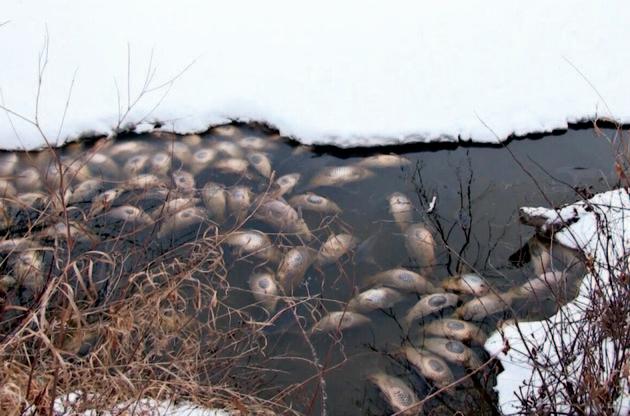
Small, shallow lakes are the most vulnerable to winterkill because they hold less water and oxygen and typically have more vegetation that dies in the winter.
In some lakes and ponds highly prone to winterkill, FWP installs solar-powered aerators that add oxygen by either stirring the water surface or sending compressed air to the bottom. n
MONTANA OUTDOORS | MARCH–APRIL 2024 | 11
NORTH
DAKOTA GAME AND FISH
LIZ BRADFORD
Winterkill on a shallow prairie pothole lake covered with thick snow.
Giving Thanks in February
At Block Management cooperators’ dinners each winter, hunters and FWP staff show their gratitude to landowners for providing access and habitat.
By Andrew McKean. Photos by Sean R. Heavey
As plates clatter and the collective warmth of a hundred people tucking into slabs of prime rib steam the winter windows of the Glendive Moose Lo dge, Nancy Cullinan describes her “trophy album.” It’s a collection of photographs of deer, antelope, and prairie turkeys taken on her family’s ranch northeast of this Yellowstone River town.
Holding each animal’s antlers, horns, and wings are hunters—most wearing grins the size of Dawson County—whom Cullinan doesn’t necessarily know by name. They’re visitors to the ranch, invited and given free hunting access through Montana’s Block Management Program. But they send photos to Cullinan every year as partial thanks for the opportunity to hunt. By all appearances, the hunting seems pretty good on the 12,000-plus-acre ranch. Hailing from Washington and Texas, Illinois and Minnesota, as well as from across Montana—many of the hunters return to the Cullinan Ranch year after year, most of them ready to make their
annual reservations the minute phone lines open in August.
“There’s pictures of first deer, biggest deer, and sometimes it’s a great big man with a tiny little forkhorn,” laughs Nancy’s husband, Jim. “We think of them all as trophies.”
Nancy Cullinan’s favorite trophy photo, adorning the cover of her album, is of a nonresident who’s been hunting the ranch for years. Last year he returned with his father, who was in the final stages of terminal cancer. It’s a photo of the two of them, posing at sunset on a rim above a web of eroded coulees and scoured washes.
“I guess that’s why we do it, why we enroll our land in Block Management,” says Cullinan, whose father-in-law has been opening his gates to hunters for 26 years, nearly since Montana’s signature hunter-access program began. “We like to see successful hunters, especially those who appreciate and respect our land. It’s also been a good way for us to manage wildlife on the ranch and to make a little extra income.”


12 | MONTANA OUTDOORS | MARCH–APRIL 2024
Andrew McKean is the hunting editor of Outdoor Life and a frequent contributor to Montana Outdoors. He lives with his family on a small ranch outside Glasgow. Sean R. Heavey is a photographer also based in Glasgow.
MULEY UPDATE FWP southeastern regional wildlife manager Brett Dorak updates guests on the status of eastern Montana’s mule deer herds and other wildlife at a landowner appreciation dinner in Glendive.

Along the way, the Cullinans and their neighbors across eastern Montana have also forged durable relationships with biologists, game wardens, and other workers with Montana Fish, Wildlife & Parks. The FWP staff administer Block Management, make sure that cooperators like the Cullinans remain satisfied with the program, and work to prevent hassles like littering and off-road driving as hundreds of hunters enter their property each season.
One way the state agency shows appreciation for the farmers and ranchers who
sign Block Management agreements is by hosting landowner dinners every winter in several towns around the state. The Cullinans and Jim’s parents, John and Dana, all came to the Glendive Moose Lodge last February to feast on prime rib, hear Block Management Program and wildlife population updates, and visit with friends and neighboring ranchers.
“The least we can do”
Layers of conversation fill the hall, including talk of calf prices, a recent drought-busting
snowfall, and whether the Glendive Red Devils had the talent and drive to make a deep run at the upcoming state basketball tournament. Looking around the packed banquet hall at faces ruddy from winter windburn, Brad Schmitz makes an accounting of the multiple thousands of acres of private land represented by the Block Management cooperators in attendance.
“You have to remember that 80 percent of our land in this part of the state is private,” Schmitz, FWP’s regional supervisor for southeastern Montana, says. “We can’t do
MONTANA OUTDOORS | MARCH–APRIL 2024 | 13
WE’VE GOT A WINNER! Above: At a landowner appreciation dinner in Glendive, FWP wildlife biologist Melissa Foster hands a door prize to a local Block Management cooperator. The prizes, donated by conservation clubs and local businesses, and the dinner are a way of thanking ranchers and farmers for enrolling their property in the popular hunting access program.
our jobs without these folks. Providing a $20 steak and an evening out with the family is the least we can do to show how grateful we are that they open their gates.”
The evening before, at the Glasgow Block Management dinner, the mood was restrained. More than half the ranchers who had planned to attend couldn’t make it, as a calving-season blizzard forced them to trade a free dinner with friends for a long night pushing newborn calves out of the weather.
The Block Management cooperators who made it to the Glasgow dinner talked about how the program has grown. “I used to have to make and hang my own [hunting access] signs and keep track of hunter days,” said Leonard Swenson, whose Milk River bottomland has been enrolled in the access program since the late 1990s. “But now the department does all that, and I can be as involved as much or as little as I want.”
The region’s best habitat

and tightened neckerchiefs against the driving snow, while F WP personnel handed out flashlights and cattle-sorting flags. The lights would help in the dark night ahead, while the flags were for the spring when calves that survived this blizzard would be ready for branding and pasturing.
from Sidney to Miles City that recognize the economic contributions of hunters attracted by Montana’s welcoming green Block Management signs.
“End of the day, every landowner involved in Block Management participates for a different reason,” says Travis Muscha, FWP’s access coordinator for Region 7. “Sometimes it’s for a bit of extra income. Sometimes it’s to better manage the hunting crowds that would come anyway. Some just like to see hunters on their place but appreciate a little help from the department. But the idea for these dinners is pretty straightfoward. They’re simply a chance for FWP to say thank you to landowners for allowing public access.”
Northeastern Montana FWP regional supervisor Drew Henry, who had worked directly with many of the farmers and ranchers in his previous role as the Glasgow-area wildlife biologist, thanked them for participating.
“We literally owe what we do to you who are out there on the ground, living and working among wildlife every day and taking care of what we consider to be the best habitat in our part of the state,” he told them.
For the most part, the transactional details of the Block Management Program—enroll ment deadlines, payments determined by hunter usage, and hunting restrictions—were absent from conversations as biologists, war dens, and access technicians shared baked potatoes and beers with the landowners.
At one table, a rancher wondered if the de cline of pronghorn on their place was part of a larger regional trend. At another, an uplandbird biologist asked and gained permission to conduct a breeding-season sharp-tailed grouse survey on a prairie ranch. In the back of the room, wheat farmers discussed the po tential risks and rewards of planting dryland corn in the spring.
As the night wound down, Block Man agement cooperators shouldered into coats
In Glendive, FWP personnel distribute Leatherman multi-tools to cooperators. Later, volunteers with a group called Hunters for Access pass around appreciation gifts, many provided by Main Street businesses
Before they part, the Glendive crowd— lively and boisterous in their first landowner appreciation dinner following pandemic shutdowns—join in singing happy birthday to John Cullinan. Ranchers in cowboy hats and farmers in Muck boots, a high-schooler still sweaty from basketball practice, FWP personnel in uniform shirts and jeans, even the volunteers who cooked and served the feast, all serenade the beaming 93-year-old, who basks in the attention of his neighbors and extended community of access providers.
FESTIVITIES AND FOOD Above: Glasgow-area rancher Leonard Swenson heads back to his table with a cattle-sorting flag. Below: Guests line up for the prime rib dinner.

14 | MONTANA OUTDOORS | MARCH–APRIL 2024
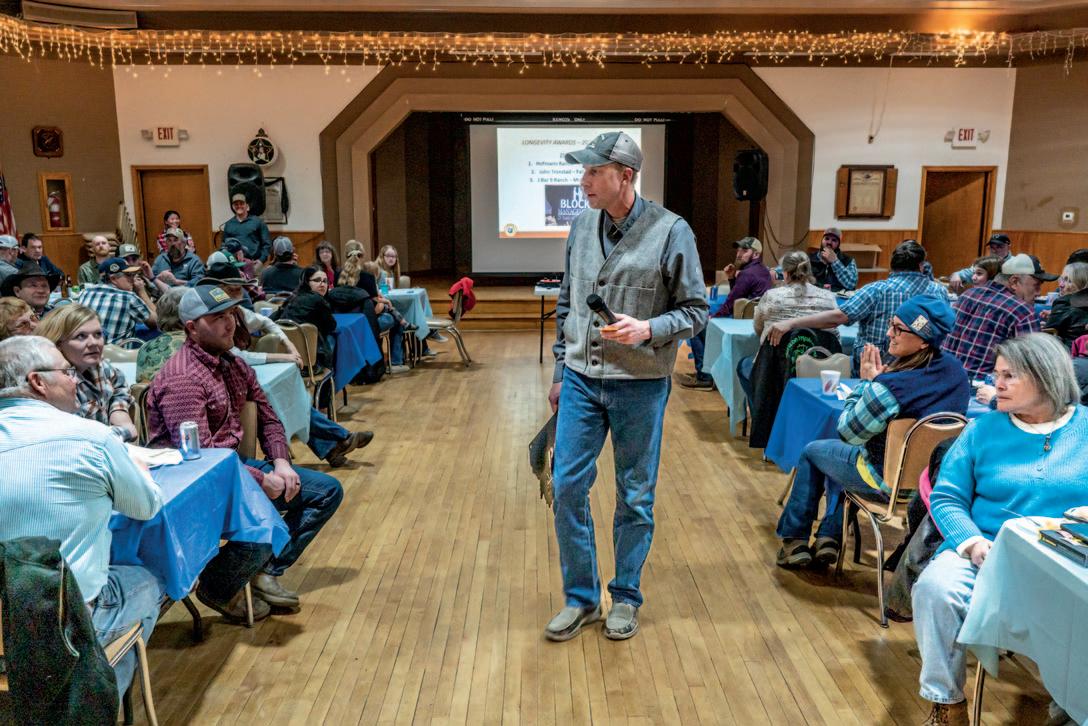



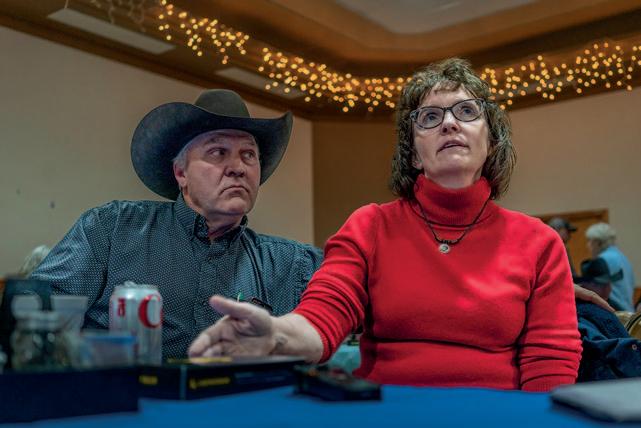
MONTANA OUTDOORS | MARCH–APRIL 2024 | 15
GREAT GATHERING Clockwise from top: Travis Muscha, FWP regional access coordinator in Miles City, with a plaque commemorating a landowner’s 25 years with Block Management; a volunteer serves up food; Wibaux-area Block Management cooperators Kip and Adele Stenson; Block Management cooperator Andrew Thiessen and his son; Region 7 Block Management staff members Annika Bollesen (left) and Bea Sturtz registering guests and handing out tickets for door prizes.

ALL CHARGED UP TO SURVEY Decked out in his “Ghostbuster” outfit (actually an electrofishing unit), FWP biologist Ladd Knotek stuns trout in a tributary of Fish Creek northwest of Missoula. Crew members capture the temporarily immobilized fish for analysis before releasing them back to the water.
PHOTO BY PAUL N. QUENEAU
16 | MONTANA OUTDOORS | MARCH–APRIL 2024
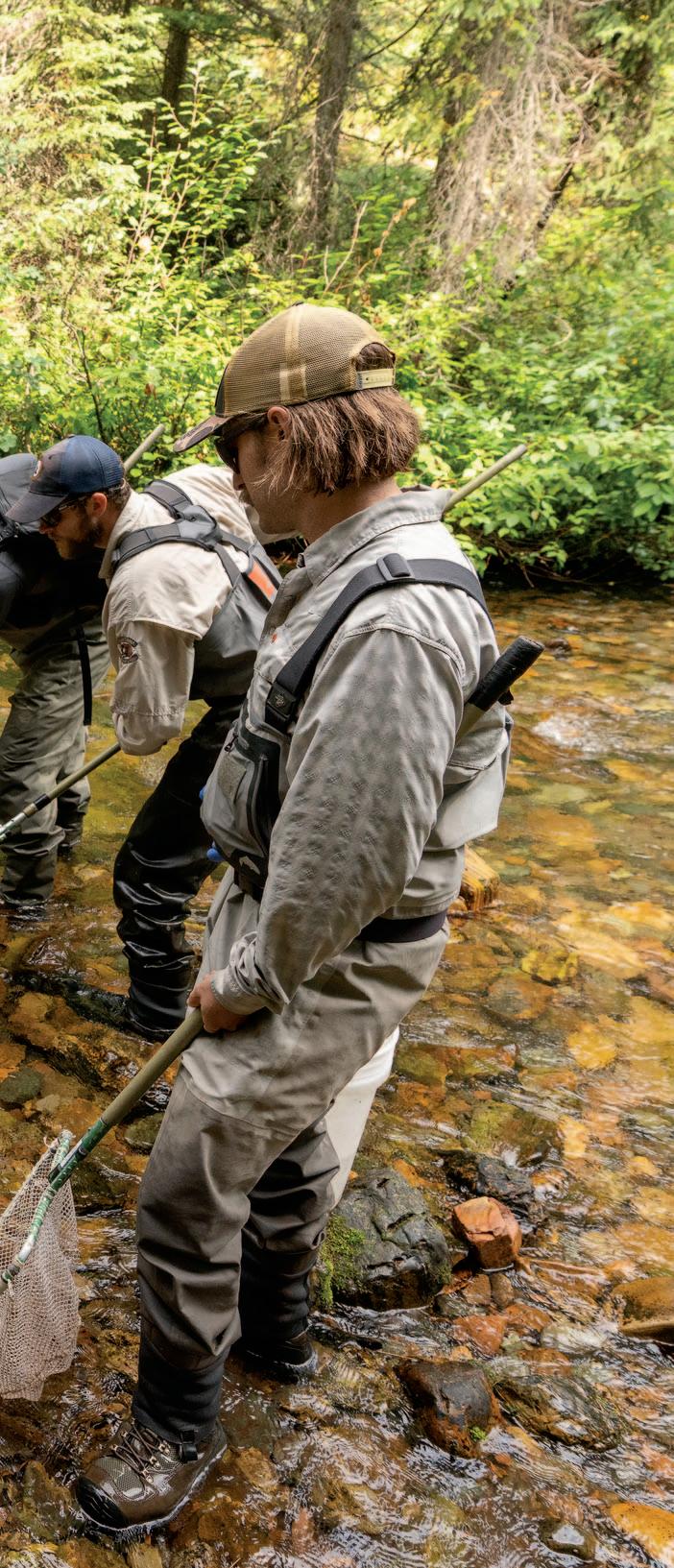
WHAT’S UP DOWN THERE?

By regularly monitoring fish populations, FWP crews gather information essential for managing and conserving Montana’s world-renowned sport fisheries and imperiled native species.
BY PAUL QUENEAU
While working for more than three decades as a Montana Fish, Wildlife and Parks fisheries biologist, Ladd Knotek has hiked hundreds of miles along mountain streams looking like one of the Ghostbusters.
That’s because he often wears a 30-pound boxy metal backpack covered in cords, dials, switches, and amperage charts perfect for zapping slimy green things—in this case, fish. And the critters are just stunned, not killed.
Called an electrofisher, the device is one of several ways FWP crews assess fish populations across the state to guide management and help ensure the future of Montana’s world-renowned trout, walleye, and other sport fisheries.
As its name implies, the electrofisher delivers a fish-stunning zap of electricity piped down a 6-foot yellow wand that biologists dip into stretches of key
MONTANA OUTDOORS | MARCH–APRIL 2024 | 17
“
fish-spawning tributaries across Montana each year. “There’s really no effective way to collect the consistent juvenile fish information we need in small streams without electrofishing,” says Knotek, who is based in Missoula. “People get freaked out by the idea, but we take extreme care not to injure the fish.”
I joined him and three other crew members last August as they surveyed Fish Creek, a popular trout stream that flows into the Clark Fork River west of Missoula. After a 6-mile hike, the sampling crew members pulled on waders and then Knotek made some adjustments on the electrofishing device. The others headed 50 yards downstream, waded in, and readied their nets as Knotek lowered a metal shocking hoop at the end of the wand into the water.
Seconds later, the netters spotted a flash of silver in the current, and with one skillful scoop, a 2-inch bull trout, temporarily catatonic from the electric current, was transfered into a water-filled bucket. In minutes the crew gathered a total of two dozen tiny bull trout and westslope cutthroat trout.
BABY BULLS
The bull trout is a federally threatened species and a Montana “species of greatest conservation need.” FWP carefully monitors the spawning success of these fish in key streams to identify problems that might put the imperiled species at further risk. “Fish
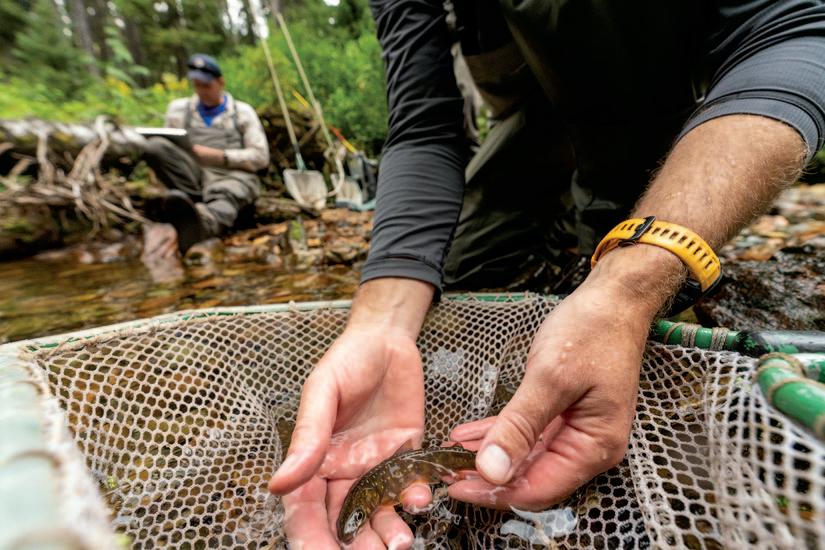
Knotek’s crew added a few drops of a sedative then began identifying and measuring each specimen. Fortunately, none were nonnative brook trout. Brookies swim in other Clark Fork tributaries and will readily spawn with bull trout, a close cousin. The hybrid offspring are sterile, which has harmed many populations of bull trout already stressed by heat, drought, and egg-smothering silt that washes in from growing road systems and other development.
Before returning each baby bull to the water, crew members took a tiny fin clip they later sent to FWP fish geneticist Ryan Kovach. Kovach oversees the University of Montana-based FWP Conservation Genetics Lab, which analyzes thousands of fish DNA samples for the department every year.
Fish Creek is the biggest bull trout stronghold west of Missoula, pretty much the crème de la crème.”
Creek is the biggest bull trout stronghold west of Missoula, pretty much the crème de la crème,” Knotek says.
The westslope, which has been petitioned for federal listing, is another highpriority species for FWP. Both bulls and westslopes need cold, clean water to spawn, which the three main forks and several other tributaries of Fish Creek steadily provide.
With the catch-bucket filled with fish,
“I can send the lab a fin clip, and just by analyzing its DNA, Ryan can tell me with 99 percent certainty which tributary of which river it came from,” Knotek says. “Bull trout have high site fidelity, meaning they spawn in specific tributaries. When we collect samples from juveniles like these in Fish Creek, we can later see if there is enough genetic diversity for the population to remain viable.”
Knotek is one of a long line of FWP fisheries biologists and technicians who have schlepped fish-finding gear into the mountains. Tom Weaver, a fish technician in FWP’s Kalispell office, recently retired after conducting bull trout surveys for an astonishing 44 years. “I’m not sure anyone on earth has walked as many miles to survey bull trout or counted as many bull trout
redds as Tom,” says FWP Fisheries Division chief Eileen Ryce, who recently honored Weaver with a career achievement award.
SURVEYING THE UNSEEN
The challenge of surveying fish populations, even for those as experienced as Weaver and Knotek, is that the subjects are underwater. Unlike wildlife counters who can at least see the animals they are trying to tally—no easy task itself—fish surveyors have to count a quarry that remains largely invisible.
Though backpack electrofishing units work well in small streams, biologists need larger boat-mounted versions to sample fish populations in rivers. Fisheries crews monitor the same sections of popular sport-fishing rivers like the Madison, Missouri, and Gallatin at the same time each fall and spring. Employing a technique called mark-recapture, they mark each fish that they stun and net by clipping off a tiny piece of fin. A few weeks later, they return to that same stretch, electrofish again, and count the proportion of marked fish to unmarked fish. When run through statistical models, done these days with the aid of computers, those numbers give biologists a population estimate, reported as the number of fish per mile.
ACTING WITH INFO
Without these and other surveys, says Ryce, FWP could not effectively manage and conserve the state’s fish populations. “We need to
18 | MONTANA OUTDOORS | MARCH–APRIL 2024
Paul Queneau is the conservation editor at Bugle in Missoula and a frequent contributor to Montana Outdoors
LITTLE INDICATOR A bull trout fingerling is measured as part of an FWP stream survey. The department also monitors fish populations on rivers, lakes, and reservoirs to see if numbers are rising, falling, or staying stable.
PHOTOS: PAUL N. QUENEAU
be able to see if a population is trending down or up,” she says. “If down, then we try to figure out why. Maybe it’s due to problems with spawning tributaries, or disease, or overfishing, or just a cyclical drop. But we can’t address problems if we don’t know what’s going on.”
Information showing a population increase is equally important. “That alerts us to things like better water quality or improved spawning conditions, and then we can look into what’s driving those and other factors when we make our management decisions,” Ryce says.
Fish surveys recently provided a warning signal that brown and rainbow trout in southwestern Montana’s legendary Big Hole, Beaverhead, and Ruby rivers were in trouble. All recorded their lowest fish counts in more than 30 years of FWP monitoring.
“That was a big red flag telling us we really need to zoom in closer to see what’s driving these declines,” says Eric Roberts, chief of the FWP Fish Management Bureau.
To help unravel the mystery of what’s ailing
“
Creel surveys provide a great check and balance to all the other data gathering we do.”
southwestern Montana trout populations, FWP is working with the Cooperative Fisheries Research Unit at Montana State University. Over the next several years, a trio of senior graduate students will study browns and rainbows in the rivers to try to figure out what’s killing them and how to solve the problem. Those applied solutions would then be documented in future trout population surveys so FWP biologists could see if they worked.
Some of the information the researchers will analyze will come from creel surveys, another way FWP monitors fish populations. During the surveys—named for the wicker baskets that trout anglers once carried to hold their catch—FWP fisheries technicians ask anglers at popular river launches, boat ramps, and other locations how many and what species of fish they caught, how many hours they spent fishing, and if they saw evidence
of fish disease or abnormalities.
“Creel surveys provide a great check and balance to all the other data we gather,” Roberts says. “And they really get at what we’re doing when we manage a fishery, which is to improve angling satisfaction. During our creel surveys, we hear those opinions directly from anglers.”
NETTING GOOD NEWS
Though fish population surveys can turn up bad news, many show the opposite. Just 20 miles north of the Big Hole and nestled high in the Anaconda-Pintlers, Georgetown Lake holds stocked rainbow and brook trout as well as kokanee salmon. In 2015, FWP added Gerrard rainbow trout to the mix, a strain famous for growing especially big.
Recent surveys have turned up the largest rainbows the lake has ever pro -

NET RESULTS Another fish survey tool is gillnetting, used in lakes and reservoirs. Here, surveyors untangle kokanee from nets set at Holter Reservoir. Survey teams record weight, age, and species for each net, which they place in the same spots during the same time each fall.

duced—as well as the biggest kokanees seen in decades, something that surprised biologists. Creel surveys bore that out, as did photos of happy anglers holding massive fish that showed up on Facebook, Instagram, and other social media.
At Georgetown, FWP fisheries crews employ a survey technique used on Montana’s major fishing lakes and reservoirs. Because electroshocking only works on narrow waters like rivers and streams where key habitat is identifiable and can be targeted, bigger waters like Georgetown need to be surveyed with 125foot-long gillnets. The nets are set at the same locations and depths each year to collect a sample of fish. Crews record fish species, size, abundance, and health while also looking for
unexpected species such as northern pike that would indicate an illegal introduction.
FWP also seines lake and reservoir shallows in summer to see how well newly hatched fish are faring. Crews set long nets in waist-deep waters, then walk them in to capture young-of-the-year fish. They sort through the catch, counting the number of each species and measuring each fish. This helps gauge the reproductive success of the year’s adult game fish as well as minnows and other forage species.
Fisheries biologists use that information to understand what might happen in the future as the fish grow and mature. For instance, high numbers of forage fish this year could increase the growth and number
of game species in the next few years. But it could also decrease catch rates, because the walleye and trout are already full of food when anglers’ baits and lures drift past.
Fall netting is another way FWP gives fish populations an annual checkup. This past October, I joined FWP Fish Habitat Bureau chief Adam Strainer and fisheries technicians Chris Hurley and Ashton Mohar on Holter Reservoir for the last of three days during which they set 15 nets across the Missouri River impoundment north of Helena. The nets nab rainbow trout, walleye, yellow perch, white sucker, longnose sucker, ling (burbot), and kokanee. “We keep track of weights, ages, and how many we get of each, which we compare to records from the past
20 | MONTANA OUTDOORS | MARCH–APRIL 2024
EVEN BIGGER ’BOWS Fish surveys show the success of adding Gerrard rainbows to Georgetown Lake. “With fish surveys, we can see if management actions like adding new strains of stocked fish end up improving the fishery or not,” says Eileen Ryce, head of the FWP Fisheries Division.
FROM LEFT: JORDAN LEFLER; JESSE LEE VARNADO

“
Shoreline seining helps us gauge the reproductive success of the year’s game fish as well as perch, minnows, crappie, and other forage species.”
30 years,” Hurley said.
The crew was hoping to see at least four to six rainbows or walleye per net, the goal in the reservoir’s fisheries management plan. They surpassed the goal and also captured far more kokanee than usual as well as massive numbers of perch. One net yielded a monster walleye that sent the crew members into a special operation. They
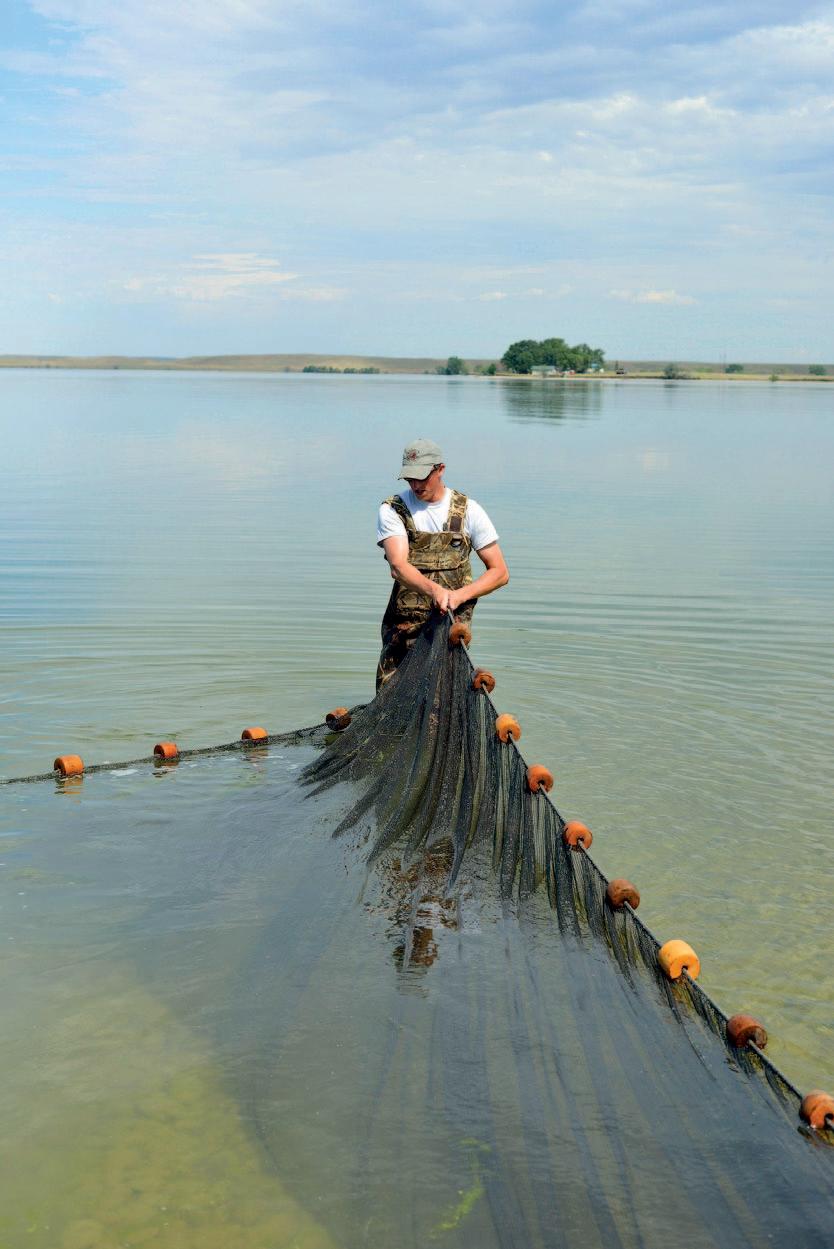
quickly recorded its length and weight— nearly 14 pounds, just 4 shy of the state record caught in Holter in 2021—then clipped a spine off its dorsal fin, to be analyzed later to determine the fish’s age, and inserted a tiny yellow tag into the base of the fin. In short order, they had the 31-inch trophy back in the water.
“We know how much anglers value catch-
ing these larger fish, so we make a special effort to keep them alive during our surveys,” Hurley said. The other collected fish of average size aren’t so fortunate. They end up “giving their lives for science,” as Strainer puts it, an unfortunate byproduct of the survey technique, though not one that meaningfully affects populations.
After the nets were gathered, the crew
MONTANA OUTDOORS | MARCH–APRIL 2024 | 21
SEIN APPROACH FWP biologist Cody Nigel pulls in a seining net at Fresno Reservoir. Crews use the fine-mesh nets in shallows during summer to see how newly hatched game and forage fish are faring.

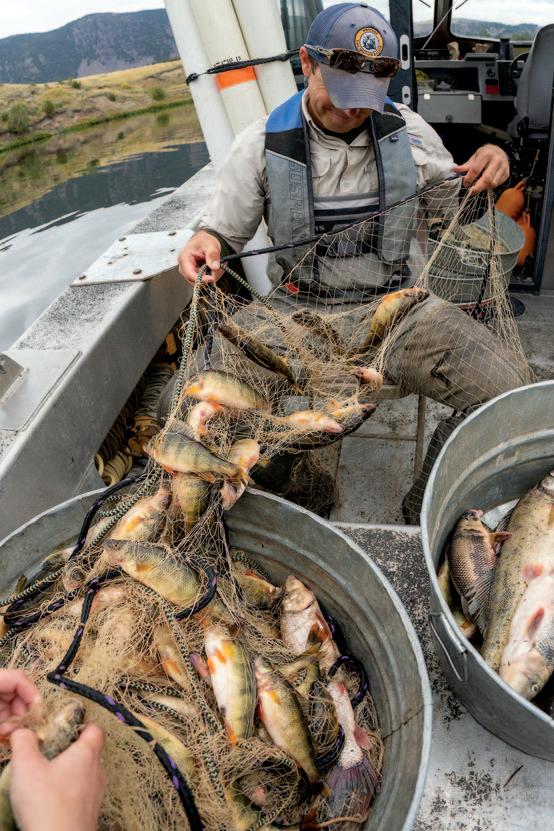
“We know how much anglers value catching these larger fish, so we make a special effort to keep them alive when we net them in our surveys.”
PHOTOS BY PAUL N. QUENEAU
a
in a nice walleye; releasing a walleye that weighed nearly 14 pounds (though most fish surveyed with gill nets “give their lives for science,” as Strainer says, FWP
to
trophy
to the water); a major haul of yellow perch, most of them from the 2019 and ’20 age classes, or generations of fish. The fall 2023 survey indicated strong numbers of walleye, kokanee, rainbow trout, and perch, all surpassing management plan goals.
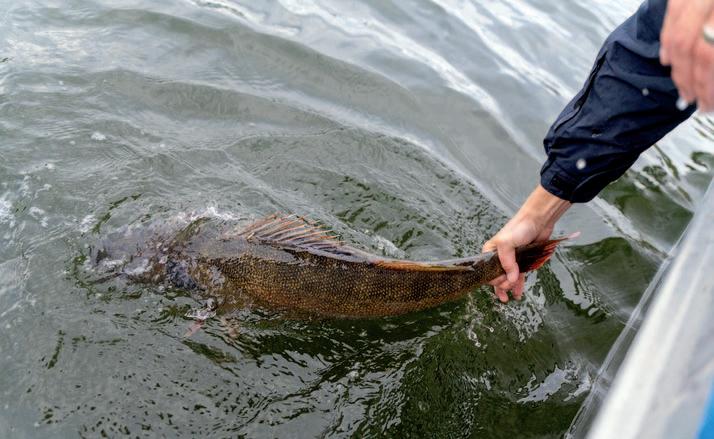 HOLTER HAUL Clockwise from above left: FWP fisheries technician Chris Hurley, FWP Fish Habitat Bureau chief Adam Strainer, and technician Ashton Mohar prepare to check survey nets at Holter Reservoir; weighing a kokanee; a big burbot (ling); sorting fish by species; walleye stomach contents (dyed with
pink preservative); pulling
crews try
return
fish
HOLTER HAUL Clockwise from above left: FWP fisheries technician Chris Hurley, FWP Fish Habitat Bureau chief Adam Strainer, and technician Ashton Mohar prepare to check survey nets at Holter Reservoir; weighing a kokanee; a big burbot (ling); sorting fish by species; walleye stomach contents (dyed with
pink preservative); pulling
crews try
return
fish




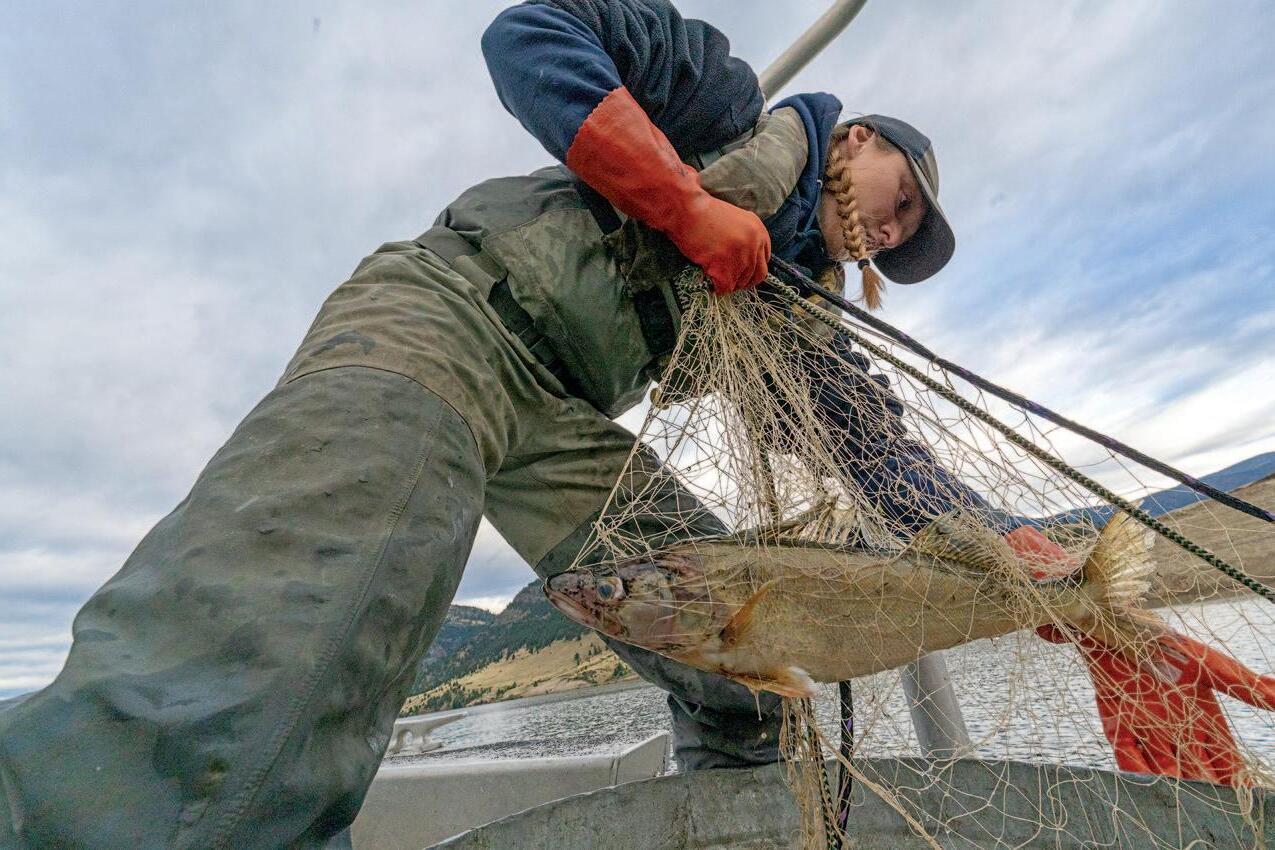
weighed and measured each fish and, from the inner ear of each kokanee and rainbow, carved out a small stonelike structure called an otolith they later examined under a microscope to determine each fish’s age. They also checked the stomach contents of walleye and burbot. Considering the profusion of perch in the nets, it was no surprise that the bellies of the two large predator species were stuffed.
By day’s end, Hurley said it was clear that Holter’s fishery remains in great shape, “though anglers may need to work harder next summer to tempt walleye already full of perch.”
That’s another benefit of fish surveys: If anglers aren’t catching fish, they can always blame their bad luck on the abundant forage fish documented in survey nets.

NIGHT AND DAY Above: After-hours electrofishing on the Missouri River gives biologists information they need to manage the river’s world-renowned rainbow trout fishery (below).

24 | MONTANA OUTDOORS | MARCH–APRIL 2024
PHOTOS: CHRIS MCGOWAN
How fisheries and aquatic system monitoring drive
FWP fisheries management
Ladd Knotek, FWP fisheries biologist in Missoula, has been counting fish and studying trout streams since the mid-1990s. He says gathering solid scientific information on fish populations and aquatic systems is essential for deciding how best to conserve, recover, and improve fisheries. It also strengthens the credibility of FWP management decisions. “Without accurate data, we’re just another opinion out there,” Knotek says.
When asked for specifics on how population and aquatic system monitoring helps resident and nonresident anglers in the Treasure State, Knotek rattles off one benefit after another:
} “When the FWP Commission considers altering fishing regulations, they often incorporate the biological considerations that FWP fish surveys and other field data provide.”
} “One of our jobs is to comment on proposed land management activities overseen by other agencies or private groups. We can’t provide credible suggestions regarding activities that could damage a nearby trout spawning tributary if we don’t back up our opinion with solid data.”
} “One way we get funding for important stream restoration projects is to show that they will address what are called ‘limiting factors’ for fish or aquatic systems. We identify those factors, such as degraded spawning conditions or the rise of invasive non-native fish species, by constantly monitoring fish populations.”
} “Similarly, recent significant land acquisitions, such as Fish Creek State Park and Wildlife Management Area and Marshall Creek Wildlife Management Area, happened thanks to millions of dollars of funding from outside sources like The Nature Conservancy. A major reason that FWP was able to compete against similar acquisition proposals in other states was by showing data on the enormous fish and wildlife values those properties contained, like key spawning habitat for federally threatened bull trout.”
} “The public wants to know if their fisheries license dollars and other contributions are being spent effectively and prudently. A major way we demonstrate that is with fish population monitoring, which shows clearly whether a problem was fixed or if we need to try another approach and then monitor again to see if the new solution worked.”

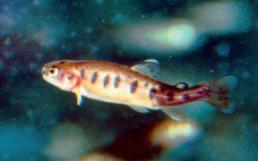
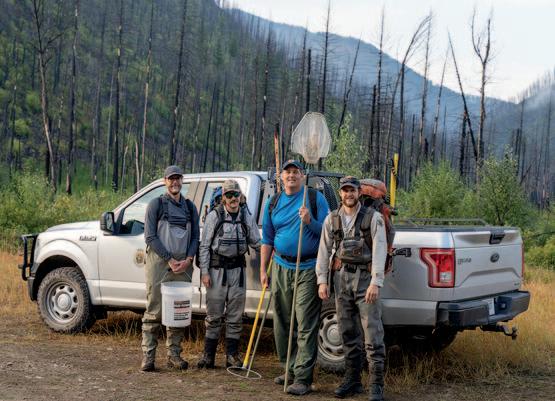
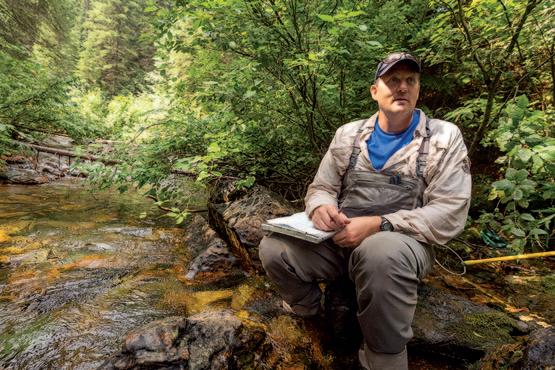
Without accurate data, we’re just another opinion out there.”

} “Fish monitoring is also how we determine the extent of damage to fisheries from accidents like the Yellowstone River oil leak in 2015 or from disease outbreaks like we had with whirling disease in the Madison River during the late 1990s, or when we see an invasive species like brook trout start to displace native westslope cutthroat. There’s simply no way of knowing how big the problem is unless you are constantly surveying the waters and seeing how the fish and the entire aquatic system are doing.” n
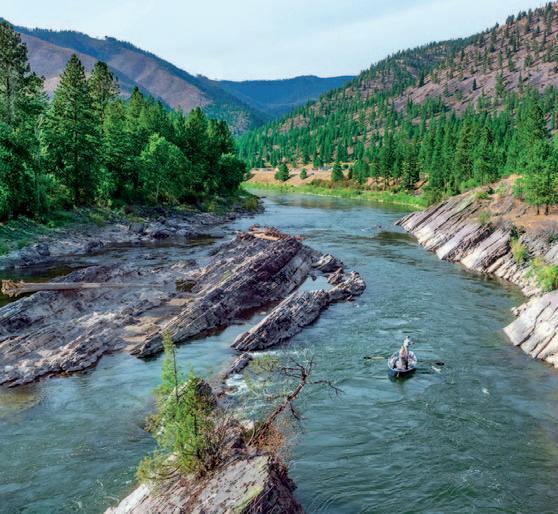
MONTANA OUTDOORS | MARCH–APRIL 2024 | 25
“
Above: 2015 Yellowstone River oil leak; below: whirling disease
CLOCKWISE FROM TOP RIGHT: PAUL N. QUENEAU; PAUL N. QUENEAU; PAUL N. QUENEAU; SHUTTERSTOCK; WHIRLING DISEASE INITIATIVE; MTN NEW S
The Clark Fork River’s Alberton Gorge near Fish Creek State Park and WMA.

26 | MONTANA OUTDOORS | MARCH–APRIL 2024

The world of wildlife beneath the white surface of winter
BY ELLEN HOROWITZ
MONTANA OUTDOORS | MARCH–APRIL 2024 | 27
I HEARD THAT A red fox buries its head in snow powder to grab a mouse detected with its keen hearing. Foxes, coyotes, and owls regularly prey on small rodents in winter by listening for the faint scurrying of tiny feet below the snow surface. PHOTO BY DAWN WILSON
Last winter while snowshoeing through the woods with my pup Louie, I found a large mound of snow with an entrance and hollowedout interior. The two colorful insulated pads left at the opening, and a few other pads inside, felt like an invitation.
It was a human-made quinzee hut. These domed structures are built by shoveling loose snow into an SUV-size mound, waiting a few hours for the snow to set and harden, then hollowing it out.
Louie entered the snow cave first. I removed my snowshoes, knelt down on a pad, and crawled inside. The interior was about 8 feet wide, and there was plenty of headroom for sitting. The air felt warm without the chill of the wind outside. Within this cozy space, I started thinking about snow as insulation, and the hidden world beneath a blanket of white. It’s easy to forget what goes on below the snow because we’re usually above it.
WINTER’S BASEMENT
Scientists divide the world of snow—the nivean environment—into three categories: the supranivean above the snowpack, the intranivean in the middle, and the sub -

nivean in the space between the ground and the snowpack.
Most people are unaware of the subnivean zone because they assume the snowpack extends all the way to the ground, says Torrey Ritter, nongame wildlife biologist for Montana Fish, Wildlife & Parks in Missoula. “But in fact there’s a space down there, like the basement of a house, that’s mostly free of snow,” he says. “With the first snowfalls of the season, the snow doesn’t pack down and fill every crack and crevice. Instead, all the rocks and logs and dead plant material hold the snow up a bit, kind of like little umbrellas, creating all these rooms and passageways.”
The snowpack above acts like a thermal blanket that holds the earth’s heat. The warmth transforms some of the snow that makes it down into the subnivean zone into water vapor. As the vapor rises and hits the bottom of the snowpack, it freezes into a layer of ice, serving as a basement ceiling. As more snow accumulates during winter and becomes increasingly heavy, the ceiling protects the subnivean space below. What’s
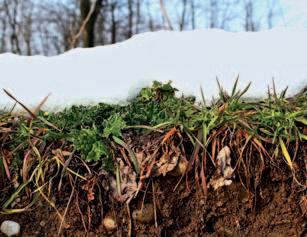
“
There’s a space down there, like the basement of a house, that’s mostly free of snow.”
more, all that snow provides insulation, keeping the subnivean layer’s temperature around 32 degrees F even when the outside air temperature drops far below zero.
It’s not exactly balmy down there in the subnivean zone, but it’s warm enough for small animals to survive.
LITTLE MAMMALS BELOW
What lives in the subnivean? Mostly mice and voles. These small rodents remain active during the day, feeding on seeds, leaves, roots, and bark. In some places they find pockets of green plants. In the squasheddown vegetation they build elaborate tunnels that connect sleeping and dining areas, food caches, and latrines—just as they do in summer. Multiple exits to the snow surface provide airflow and opportunities to find food above the snowpack in the supranivean zone.
Shrews, Montana’s smallest mammals, also prowl the subnivean. Shrews have voracious appetites needed to sustain their hyper metabolism. To stay warm, they must eat one to two times their own body weight in food per day. Shrews mostly consume insect eggs and pupae, adult beetles, beetle larvae, spiders, and other invertebrates, as well as the occasional baby mouse or vole.
Two larger mammals that also use the subnivean are the American pika and the wolverine. Also known as a rock rabbit, the pika has dense fur and small, rounded ears that reduce heat loss. This fist-sized rabbit and hare relative lives in boulder fields
Continued on page 32.
28 | MONTANA OUTDOORS | MARCH–APRIL 2024
Ellen Horowitz is a writer in Columbia Falls and a longtime contributor to Montana Outdoors
SELF-SUBNIVEAN Sometimes people create their own subnivean zone by building a quinzee hut. These temporary outdoor shelters make use of the snow’s insulating qualities to provide protection from the cold and wind just like how the subnivean layer beneath the snowpack protects mice, voles, and other small creatures.
FROM LEFT: SHUTTERSTOCK; JIM EVANS/OUTDOOR CANADA; CONNIE FISKE & RON PAUL
SUPRANIVEAN INTRANIVEAN SUBNIVEAN GROUND

DANGER BELOW A short-tailed weasel holds a vole caught in the space between the ground and the snowpack.
MONTANA OUTDOORS | MARCH–APRIL 2024 | 29
The Subnivean Zone
Illustration by Liz Bradford
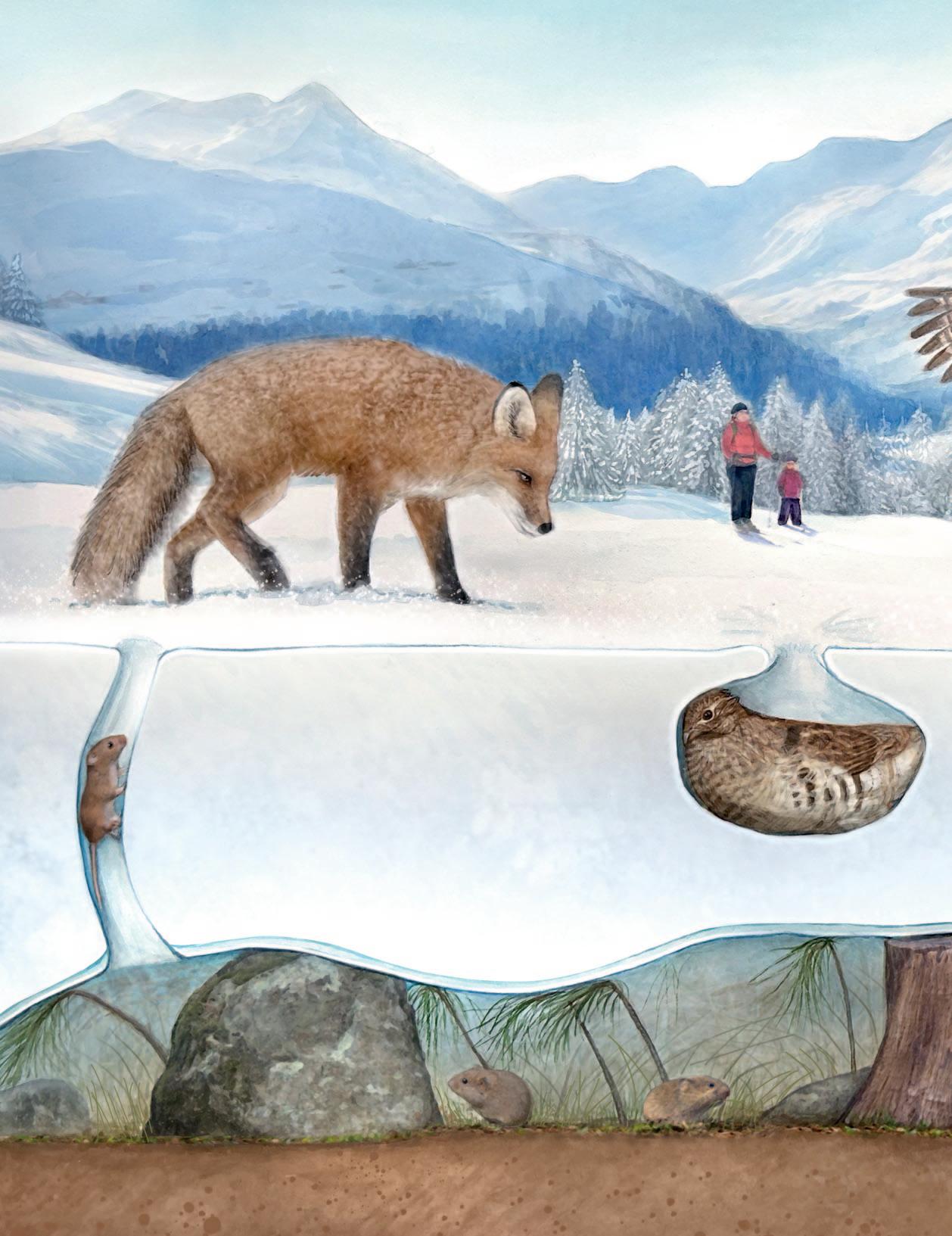
As you hike or ski across the snowpack in the supranivean zone, picture the world below your feet in the intranivean (snowpack) and subnivean (beneath the snow) zones.
The subnivean zone is created by the very first snowfalls of the year. The snow is held up a few inches or more by rocks, stumps, logs, and bent plants that act like little umbrellas. This creates a basement-like space between the snowpack and the ground.
The snowpack acts like an insulating blanket, trapping heat from the earth. Some of the snow down there turns to vapor and rises up, hitting the bottom of the cold snowpack and turning to ice. This forms a ceiling that protects the subnivean space as more and more snow falls throughout the winter and gets heavier and heavier.
INTRANIVEAN ZONE
30 | MONTANA OUTDOORS | MARCH–APRIL 2024
1 2 1 2 6 5
4
SUPRANIVEAN ZONE
Living in the subnivean zone are mainly mice, voles, and shrews. The mice and voles feed on grasses and other plants while the shrews eat mostly insects.
The mice and voles build tunnels in the snow so they can bring in air and climb out to feed on grass and other plants above the snow. They also build tunnels in the bent grasses below the snowpack. You can see these tiny trails in the grass after the snow melts in spring.
Weasels, owls, foxes, and coyotes hunt from the supranivean zone. Weasels are slender enough to
SUBNIVEAN ZONE
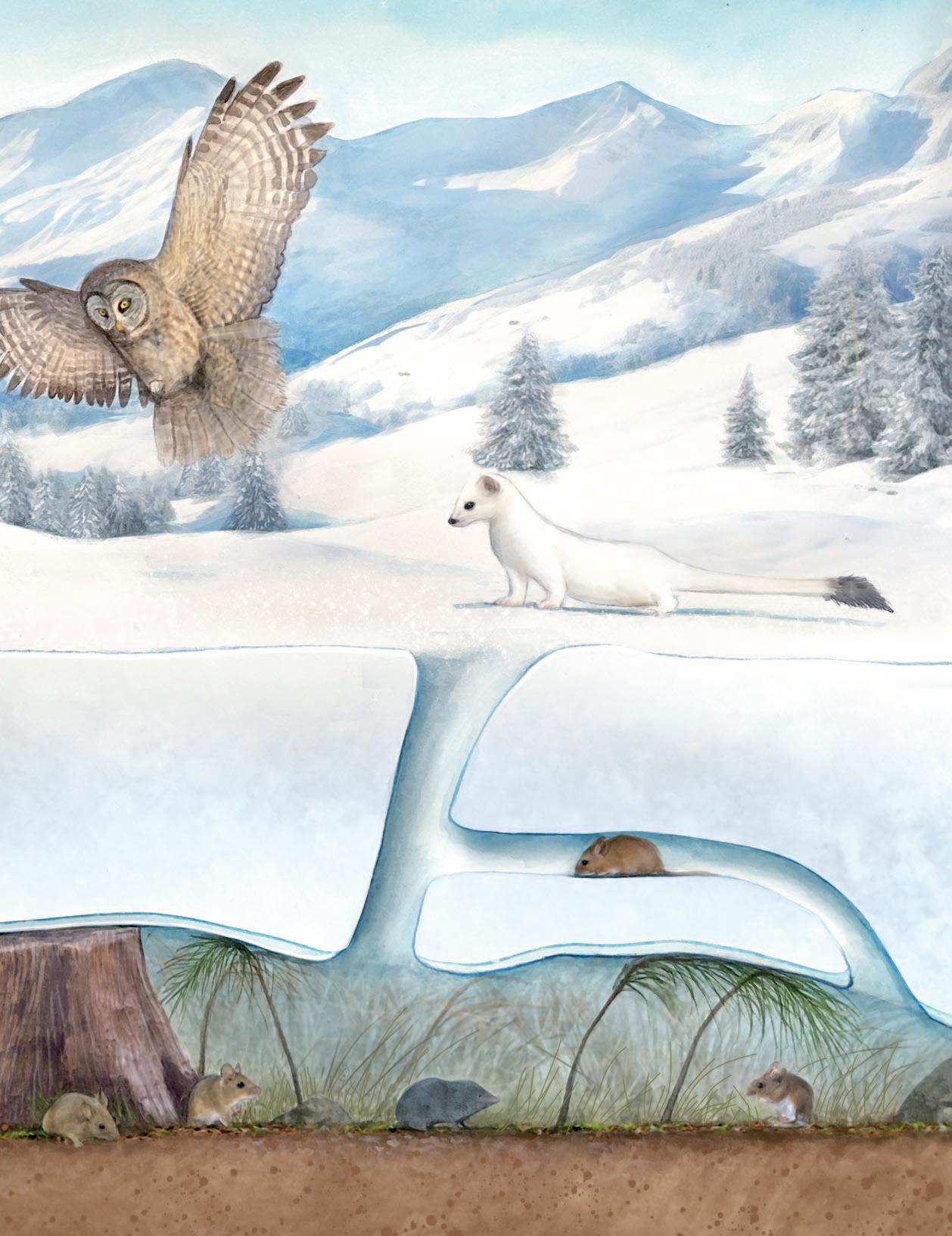
enter tunnels and hunt mice and voles. Other predators listen for the sound of the small rodents scurrying below, then dive through the snow to catch them.
Ruffed grouse sometimes plunge down into soft snow and spend a cozy night or two in a small space they create by wiggling around.
MONTANA OUTDOORS | MARCH–APRIL 2024 | 31
3 4 5 3 4 5 4
6 5
Clues to subnivean activity
Tracks and tunnels

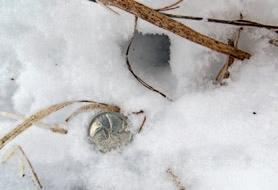
Watch for holes in the snow where small animals enter or exit the subnivean zone. Evidence of weasels atop snow include small, paired tracks with five claws on each foot. Since they travel by bounding, their hind tracks fall directly on top of their front tracks, unlike those of mice, voles, and shrews.

Wing prints
Voles are notorious for feeding on the tender bark of young trees and shrubs beneath the snow. Their teeth marks show up as light-colored gnaw marks on woody stems.
As snow begins to melt in early spring, look at the ground for the long, winding grooves in matted grasses that show where mice and voles traveled back and forth the previous few months.
A ruffed grouse evacuates its snow roost by flushing with an explosion of wings and snow. By examining the exit hole, usually a foot or so from the entrance hole, you can see the hollowed cavern and grouse droppings. A few droppings likely indicate a single overnight stay, while a large pile signals a longer stay within the well-insulated, under-snow shelter.

Snow Fleas/Springtails
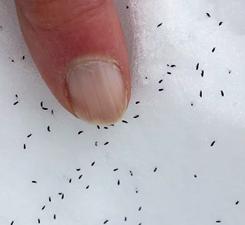
The best opportunity to find these tiny (1⁄10 -inch-long) insect-like creatures is when the air temperature warms to around 32 degrees F. That’s when snow fleas migrate up to the snow surface. Their ability to “jump” comes from a tail-like appendage (called a furcula) attached beneath the abdomen and held in place with a clasp-like structure. When the furcula releases, the snow flea is catapulted several centimeters through the air, hence its other common name, springtail.
During winter thaws, snow fleas resemble specks of dirt or black pepper sprinkled on the snow. It’s not unusual to find them around the base of trees or lining ski tracks or moose tracks, or appearing as tiny, dark jumping flecks.
From page 28.
and rocky talus slopes next to alpine and subalpine meadows. Active all winter, the pika spends most of its time in dens and tunnels in the subnivean zone, sometimes under 40 or more feet of snow, where it is protected from frigid temperatures and blizzard conditions. Much of the pika’s winter food comes from the plants it harvests, dries, and caches in “hay piles” during summer.
With their wide, snowshoe-like paws, wolverines travel easily over snow. But they also move under the snowpack into spaces that form beneath fallen trees and boulders.
This seasonal refuge offers insulated resting places, hiding cover, food caches, and dens for wolverines to give birth and raise their kits.
White-tailed ptarmigans, dusky grouse, and ruffed grouse also spend time under the snowpack. During rugged winter weather when the mercury plummets and winds howl, a ruffed grouse will dive headfirst from a tree perch into soft, deep snow and disappear completely from sight. The bird then wiggles a bit to create a little snow cave, where it can spend one or more nights in relative comfort, insulated by the surrounding snow. In the morning, the grouse bursts out of the roost and flies off.
DINNER BENEATH THE SNOW
As they do the rest of the year, many predators hunt the mice and voles that live in the subnivean. Three weasel species live in Montana. Each has fur that turns white in winter to camouflage it from other predators while moving across snow. Their thin coats, however, aren’t adequate to keep the sleek predators warm. Weasels “can’t deposit fat on their frames nor produce thick, bulky coats during winter because they have to fit through tight vole tunnels,” writes Dr. Kerry Foresman, author of Mammals of Montana. After capturing and eating a vole or mouse, short-tailed and least weasels are known to curl up and nap in the
32 | MONTANA OUTDOORS | MARCH–APRIL 2024
Subnivean exit holes
Vole tunnels in compacted grass
Snow flea
Ruffed grouse wing prints at the exit of an overnight snow den
FROM LEFT: STEVEN AKRE; NATURE GUELPH TRACKING CLUB; SHUTTERSTOCK; NATIONAL PARK SERVICE
tunnel of their victim before moving on to the next meal. Due to their high metabolism, weasels must feed five to ten times per day to stay warm enough to survive.
Though tree squirrels up above are their main prey, American martens also hunt voles and mice in the larger spaces of the subnivean zone under windblown trees, branches, and logs. These snow-covered shelters also provide a warm place to rest and digest.
The sound of scrabbling little rodent feet in subnivean tunnels catches the attention of foxes and coyotes. They listen intently, cocking their head from side to side to determine the location of potential prey. When ready, they leap into the air and then plunge into the snow. If their timing is right, they catch something to eat.
Owls are even more skilled at pinpointing sounds below the snowpack. From up to 90 feet away, a great gray owl can detect voles digging tunnels in snow that’s more than 16 inches deep. Once the sound is located, the bird glides into position on silent wings and plunges into the snow talons first. Imprints from the raptor’s large wings often appear at capture sites.
OTHER LIFE IN THE SUBNIVEAN
In addition to animals, snow cover protects soils and vegetation from freezing temperatures and drying winds. Most of Montana’s herbaceous (non-woody) plants lie dormant as seeds or root stock during winter. In late winter and early spring, enough low-level
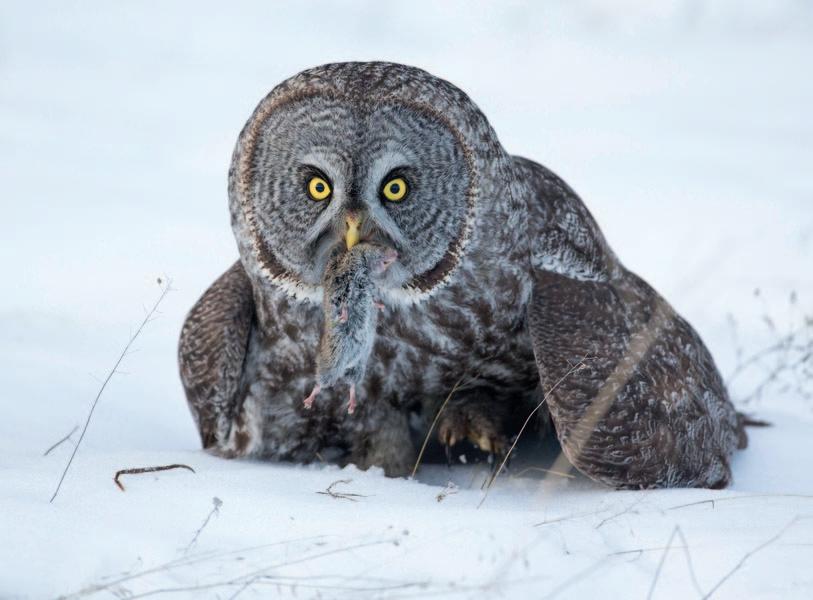
ZEROED IN Great gray owls have remarkable hearing aided by a dish-like face, which directs sound waves into their ears. The owls can detect an under-snow mouse or vole from 90 feet away.
photosynthesis can take place to trigger blooms on glacier lilies and pasqueflowers pushing up through melting snow.
The subnivean is also home to even smaller forms of life. Cold-tolerant fungi, commonly called snow mold, grow in and under deep snowpack. While some types of snow mold are pathogens on dormant vegetation, others decompose leaf litter and other organic matter.
In a study published in the journal Soil Organisms, researchers looked at microarthropods—small insects, spiders, and insect-like organisms such as springtails and mites—that fed on fungi below the snow.

They found that many of these species “feed continuously on gray mats of fungal hyphae and spores mixed with decaying plant matter.”
In other words, snow molds are the foundation of the subnivean food chain. They are eaten by snow fleas and beetles, which are consumed by predatory mites and spiders, which then get devoured by shrews and other small mammals.
Snowpack is not always a benevolent blanket of warmth. After rapid melting or rain, small animals can get wet and die from hypothermia, or drown as water rushes through a tunnel like a flash flood. A grouse can get trapped under a crust of snow and freeze to death. Or it can try to plunge into a seemingly soft snowdrift that in fact is covered by a hard crust and be wounded or killed upon impact. Then there’s the fact that Montana winters are warming and producing less snowfall, fewer days of snow on the ground, and snow that is melting faster in the spring.
Montana may have less of the white stuff than in decades past, but there’s still enough to create subnivean zones across the state. When my pup Louie and I emerged from that abandoned quinzee hut last winter, we reentered the outer world of sun and light. But as we walked home across the snow, I thought of the dark snow basement below our feet and all the living creatures scurrying and scrambling to survive down there.
MONTANA OUTDOORS | MARCH–APRIL 2024 | 33
SNOW SLEEPING BAG Like ruffed grouse and dusky grouse, Montana’s white-tailed ptarmigan will burrow into the intranivean zone for a night or two to stay warm during especially harsh weather.
FROM TOP: DONALD M. JONES; DAWN WILSON
A Lifelister ’s Paradise
Every dedicated Montana birder needs to migrate to the Westby area for a few days in springtime.
By Sneed B. Collard III
My buddy Scott and I pulled into Onstad Park in Westby full of nervous excitement. We had already spent three days in late May birding our way from Missoula across central and eastern Montana, but this was our ultimate destination.
The tiny town of Westby lies in the extreme northeastern part of our state, straddling the North Dakota border only 10 miles from Canada. With a population of less than 200, it’s a place so small and out of the way that most Montanans have never heard of it. But for birders, Westby and surrounding areas are the place to see birds we can’t find anywhere else in the state.
What makes this area so special? Location. Location. Location.
“The extreme northeast of Montana is part of what’s called the Missouri Coteau, or Missouri Plateau—a narrow region of rolling mixed-grass prairie and wetland potholes that stretches from southern Saskatchewan to South Dakota,” says Heather Harris, FWP’s grassland and wetland coordinator. “Not only is it prairie pothole country, making it part of North America’s ‘duck factory,’ it’s part of not one, but two north-south migration routes, or flyways.”
Most waterfowl hunters know that northeastern Montana sits almost dead center in the continent’s Central Flyway. Of greater importance for birders, the area also catches the far western edge of the Mississippi

Flyway. That means it is visited by a variety of typically eastern birds that seem distinctly out of place in Big Sky Country. Some actually breed in northeastern Montana, but many others are tree-loving species like vireos, thrushes, flycatchers, and warblers that clip the corner of the state each spring on their way to forested breeding grounds in Canada and Alaska.
The same birds also stop in Westby during early fall as they head south for the winter.
In addition to being surrounded by wet-

lands and prairie, the town of Westby provides an oasis of trees in a mostly prairie landscape. With its leafy park and neighborhoods, Westby and surrounding prairie-wetlands make the area a must-visit destination for Montana birders—especially those trying to add to their life or state birding lists. Birders who regularly attempt to do a Montana Big Year—viewing the greatest possible number of species in a calendar year—must visit the Westby area each spring if they hope to hold their heads high in the state’s birding community.
SONGBIRDS GALORE
Westby’s main attractions are the migrating warblers, vireos, thrushes, orioles, and other songbirds that are not ordinarily seen elsewhere in the Treasure State. As Scott and I set out exploring Onstad Park, a two-acre park lined with massive cottonwoods in the center of town, we particularly hoped to see types of rare eastern warblers and other songbirds that I had yet to add to my life list.
Our expectations were buoyed when two groups of birders told us they had recently sighted a mourning warbler, a Philadelphia vireo, and a black-throated green warbler. Alas, none of these birds cooperated with us, but before we left the park, a stunning orange-and-black Baltimore oriole zoomed across our field of vision while several purple martins flitted overhead.
While walking Westby’s main streets, we spotted other birds, including two species high on my “to see” list. The first was a stunning male rose-breasted grosbeak singing merrily from the top of a tree. Walking a side street 20 minutes later, Scott and I watched a pair of orchard orioles. That species has been breeding in eastern Montana only since the 1970s, but the heart of their range runs from Nebraska southeast to Alabama,
34 | MONTANA OUTDOORS | MARCH–APRIL 2024
Sneed B. Collard III is a writer in Missoula. Westby
CLOCKWISE FROM BOTTOM LEFT: SNEED COLLARD; DAWN WILSON; DONALD M. JONES
MADE IT The author celebrates arriving in Westby with a birding buddy. The tree-filled town amid a landscape of wetlands and prairie makes a natural stopover for migrating warblers, vireos, thrushes, and flycatchers.
so every sighting is a treat. According to range maps, rose-breasted grosbeaks do not breed in Montana, but because their breeding range extends north of us into Alberta and beyond, many of them barrel through each spring, creating great excitement for birders lucky enough to spy one.
As much as we would have liked to spend the entire day searching for songbirds, however, Scott and I also had other birds to find.
SURROUNDING SHORB-BURBS
In addition to songbirds in town, the Westby area offers one the state’s best opportunities to see migrating shorebirds. These species generally breed in Arctic Canada and Alaska and, like the songbirds, just brush Montana’s northeastern corner as they migrate. On our way into Westby that first morning, I had hit the brakes when I spotted a suspicious longlegged bird with a slightly curved bill in a puddle up ahead. A quick look through our spotting scope confirmed my hunch. It was a stilt sandpiper, a bird I’d seen only twice before in Montana.
Scott and I headed a mile north of Westby to Round Lake, part of a wetlandprairie complex designated an Important Bird Area by the National Audubon Society. There we encountered several groups of “shorbs” that included ten sanderlings and four red-necked phalaropes on their way to the Arctic. Next we headed to Upper Goose Lake, south of town. We were watching a large flock of sanderlings, stilt sandpipers, Wilson’s phalaropes, and semipalmated sandpipers when Scott received a phone call he had to take.
While waiting for him to finish his call so we could head to the next shorb hotspot, I happened to glance at the shoreline below me and saw a small, sand-colored bird land 150 yards away. I thought, “No way,” while quickly swinging the spotting scope toward the bird. As I focused in, my heart beat faster.
Yes! A piping plover!
Sadly, fewer than 10,000 piping plovers remain on the planet, and they are divided into three distinct populations. The alkali ponds of northeastern Montana provide important nesting habitat for the 100 to 200 birds of the Northern Great Plains population. I’d dared only hope to ever see one in
my lifetime. Now, this dainty, short-beaked bird was casually hunting worms and crustaceans before my eyes!
As if that wasn’t exciting enough, Scott and I drove back by the same spot half an hour later and I spotted another small plover, though darker. It was a semipalmated. This species’ populations are in better shape than its sand-colored relatives, but unlike the piping plover, the semipalmated nests much farther north in Canada, making the sighting a special thrill for me and Scott.
Both birds were a terrific way to wrap up our wonderful day of birding—and a guarantee that we would return to this remote migratory bird mecca.
I happened to glance at the shoreline below me and saw a small, sand-colored bird land 150 yards away. I thought, “No way.”
If you go
When to go: Peak migration seasons are from mid-May to mid-June, and then from mid-August to mid-September.
Where to stay: The nearest motels are in Plentywood, 26 miles west of Westby. Camping opportunities are widely available.
Where to bird: In addition to places mentioned in this article, check out the parks in Plentywood as well as Medicine Lake National Wildlife Refuge, Brush Lake State Park, and the Culbertson Bridge Fishing Access Site on the Missouri River.
Essentials: Bug spray, food and drink for lunches, binoculars, and, if possible, a spotting scope. Note that gas stations are as rare as piping plovers in this part of the state, so fill up whenever you have the chance.

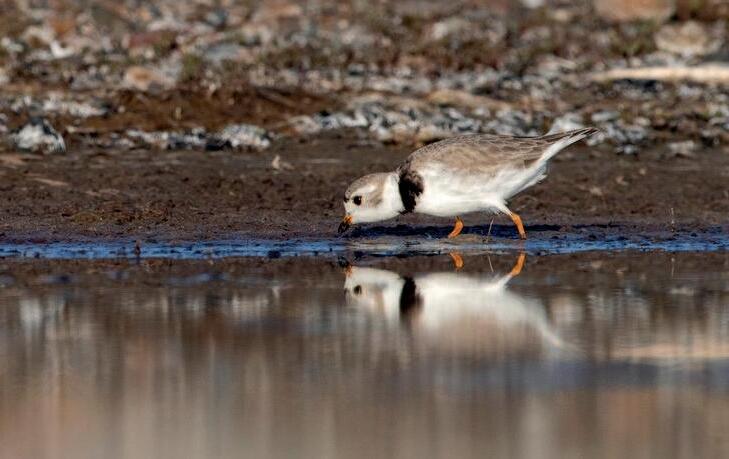
MONTANA OUTDOORS | MARCH–APRIL 2024 | 35
1 OF 200 The relatively rare piping plover is just one of the many shorebird species that show up in the prairie-wetland complexes that surround Westby in far northeastern Montana.
Orchard oriole

FWP biologists fight rainbow trout
cutthroat east of the Continental Divide from
36 | MONTANA OUTDOORS | MARCH–APRIL 2024
Saving Montana’s

Prairie Trout hybridization to save westslope
local extinction.
By E. Donnall Thomas, Jr.
ontana Fish, Wildlife & Parks fisheries biologist Clint Smith, fisheries technician Rob Beattie, my wife Lori, and I are driving east toward the crest of the Judith Mountains 20 miles north of Lewistown, where Lori and I live. Although I’ve spent decades exploring this terrain, I’ve never seen or heard of our destination: Alpine Gulch. As we turn south on a barely passable two-track on this August afternoon, the reason becomes apparent:. The rocky creek bed is completely dry. Since our mission today is to find fish, this would seem discouraging, but the lack of water here turns out to be one of the very reasons the population of westslope cutthroat trout we seek still exists.
Despite its name, the westslope cutthroat’s historic range extended well east of the Continental Divide to the Little Belt, Crazy, Highwood, and Judith mountains. At one time westslopes swam in streams that flowed past the vast herds of bison, and before them the woolly mammoths and giant sloths that roamed these grassy plains.
But the same westslope populations that survived multiple ice ages have struggled since Montana became a state and was settled. Over the past 50 years, the species’ historic range east of the Divide has declined by a stunning 90 percent. Today, some headwater streams contain only a few dozen nonhybridized westslope cutthroat, and FWP rates the risk of local extinction for many populations as “high to extreme.” This has made saving the species east of the Divide a top priority, says Eileen Ryce, FWP fisheries chief.
The greatest driver of this decline— stocking non-native fish—illustrates the law of unintended consequences.
In the early 1900s, the state and local angling clubs stocked brook, brown, and rainbow trout throughout much of Montana, including the streams where westslopes swam. The non-natives competed with the westslopes for food and habitat—and usually won.
MONTANA OUTDOORS | MARCH–APRIL 2024 | 37
PAT CLAYTON/ENGBRETSON UNDERWATER PHOTOGRAPHY
To make matters worse, rainbow trout interbreed with their cutthroat cousins to create a hybrid known as a cutt-bow. Even tually, all the unique genetics of westslopes on the prairie may be gone—and with them, biologists fear, the ability to adjust to the region’s changing environment, something westslopes have done for thousands of years.
Our crew’s goal today is to capture two dozen westslopes upstream of the dry stretch, which has mostly kept them isolated from rainbow trout. After clipping a tiny piece of fin tissue for genetic analysis at FWP’s genetics lab at the University of Mon tana, we will release the fish back into Alpine Gulch’s headwaters. A 2015 study showed that Alpine Gulch westslopes were 99.5 per cent genetically intact. By 2019 that had slipped to 98.1 percent. Smith and others want to know if the downward trend is continuing—in which case they would have to figure out a way to protect the population.
Smith shoulders a backpack containing electroshocking equipment, Beattie grabs an armload of nets and specimen containers, and we set off uphill in search of cutthroat habitat—hopefully with some water in it.
EAST VS. WEST
The Westslope Cutthroat’s Shrinking Range

Like all trout and salmon of the genus Oncorhynchus, cutthroat originated in the North Pacific where the coastal subspecies still migrates between freshwater and saltwater. Cutthroat spread inland throughout the Great Basin and Rockies some 2 million years ago, when Pleistocene Epoch glaciation created new topography and stream flow. The species adapted to this dispersal process better than other Pacific salmonids; rainbow trout didn’t make it across the Continental Divide until humans put them there.
Cutthroat migrated eastward up the Columbia and Snake rivers, and the westslope cutthroat, named for its abundance in the headwaters of the Pacific drainage, retained the moniker even on the far side of the Divide. (The westslope’s close cousin, the Yellowstone cutthroat, has a native range extending even farther east, to today’s Miles City.)
This wide dispersal benefited cutthroat by
Kalispell
Marias River
Choteau
Teton River
Great Falls
Missouri River
Missoula
Helena
Havre
Fort Benton
Judith River
Alpine Gulch
Lewistown
Less than 10% hybridization
Historic distribution
Continental Divide
Madison River Jefferson River
Dillon Bozeman
OUT FROM THE ROCKIES
SOURCE: MONTANA FWP
introducing them into a variety of habitats— a biological version of not putting all your eggs in one basket. If for some reason a population failed to thrive in, say, Kootenai River tributaries in southwestern British Columbia, or in Sheep Creek, southwest of Dillon, the species would continue to survive.
Historically, the range of westslope cutthroat trout extended east into the prairie to today’s Lewistown and on the Missouri and Teton rivers downstream to Fort Benton. Brown, brook, and rainbow trout introduced in the 20th century have muscled the native fish out of most of their range east of the Continental Divide. Rainbows also hybridize with cutthroat, reducing the number of populations with unaltered genes to a fraction of former levels.
One problem, though, is that small, isolated populations end up with restricted gene pools that can lead to inbreeding that results in decreased survival and reproductive success. Denied access to fresh genes, inbreeding can produce offspring less capable of dealing with environmental changes or competing against invasive species.
Allowing westslope cutthroat to disappear from their native range is not going to happen if we have anything to say about it.”
West of the Continental Divide, cutthroat populations have contracted much less, likely because the habitat includes large expanses of contiguous mountains with abundant cold water and fewer roads and other human infrastructure.
In contrast, westslopes on the eastern edge of their historic range are now limited to small, isolated headwater streams like Alpine Gulch in island ranges. Historically, these island mountains receive a deeper snowpack
38 | MONTANA OUTDOORS | MARCH–APRIL 2024
E. Donnall Thomas, Jr. is a writer in Lewistown and a longtime contributor to Montana Outdoors
MAP:
MONTANA FWP
“ ”
and produce more consistent stream flows in summer than the surrounding warmwater prairie streams, allowing cutthroat to thrive.
But over the past century, forest access roads and culverts have prevented native trout from migrating up- and downstream, where they can reproduce with cutthroat containing different genes, thereby lessening genetic isolation.
Add to that hard-rock mining and other
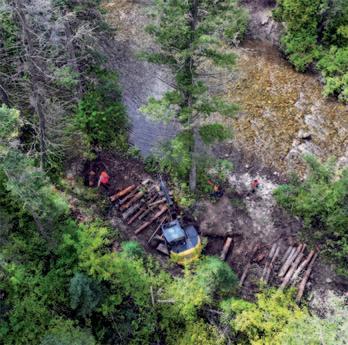
human actions that degrade cutthroat habitat. For instance, years of unauthorized fourwheeler crossings on the Middle Fork of the Judith caused silt to wash downstream, smothering trout eggs and suffocating aquatic insects. In 2023, Trout Unlimited and the U.S. Forest Service rerouted most of the trail, which will allow the stream to flush out silt and recover.
CLEANING THE SLATE
Keeping four-wheelers out of streams definitely helps westslopes, but not nearly as much as keeping non-native trout from muscling out or breeding with the native trout. Though it’s been decades since anglers
REDIRECTING THE FOUR-WHEELERS
and FWP dumped buckets of browns, brookies, or rainbows into westslope streams, the introduced species are thriving and reproducing naturally.
That’s fine if you like catching those fish. But not if you’re trying to recover native westslope trout.
To eliminate rainbows and hybrids from key westslope habitat, FWP uses rotenone, a plant-derived fish-killing chemical used to remove unwanted species. It affects only gillbreathing animals, and it breaks down quickly. FWP then restocks treated waters only with cutthroat.
Blocking rainbows from reaching headwater cutthroat habitat is another way to
Left: In 2023, Trout Unlimited and the U.S. Forest Service rerouted a four-wheeler trail that repeatedly crossed the Middle Fork Judith River, causing massive siltation downstream. The new route will keep vehicles away from the stream and allow the habitat to recover. That will open the possibility of FWP someday protecting the remaining cutthroat in the headwaters that have unaltered genes. Below: Historically, mountain streams east of the Divide, like the Middle Fork Judith River, held strong populations of genetically intact westslope cutthroat. Today almost all of the native fish in this and most other streams have been hybridized with nonnative rainbows.

MONTANA OUTDOORS | MARCH–APRIL 2024 | 39
FROM TOP: BILL PFEIFFER/MONTANA TROUT UNLIMITED; JOHN LAMBING
protect native trout, and sometimes nature does the work. For instance, the water in Alpine Gulch disappears underground for 1.5 miles and seeps through porous limestone into Warm Spring Creek and then the Judith. The same thing happens on the South Fork of the Judith in the Little Belts. The dry stretches block upstream rainbow migration.
Unfortunately, the stretches sometimes flood in spring, allowing rainbows to move upstream. That’s likely how a handful of rainbows reached upper Alpine Gulch and began breeding with the native trout.
Another way FWP aims to preserve isolated cutthroat populations is with a process called “genetic rescue,” used successfully on inbred wildlife like the Florida panther. FWP geneticist Ryan Kovach leads a team
exploring this novel approach to restoring westslope cutthroat genetic health.
From 2017 to 2023, FWP and the University of Montana conducted an extensive genetic study of multiple cutthroat populations in eastern Montana. They identified the best candidates for genetic rescue: isolated populations with little genetic variation within the population and genetics that vary considerably from other nearby populations. Trout from healthy gene pools were then introduced into four populations that met those criteria.
DOESN’T TAKE MANY
Wildlife studies show that adding just a few new individuals may successfully improve genetic diversity within an isolated popula-
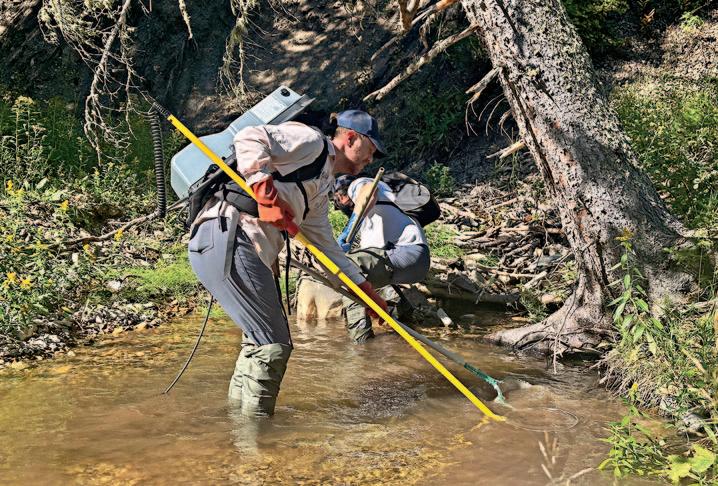

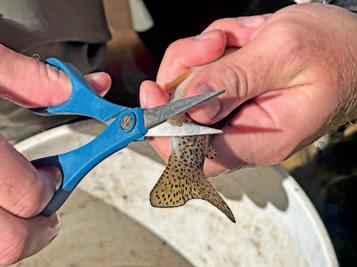
tion. The same may hold true for fish. A complete assessment of the eastern Montana experiment will require several years to study the genetics of multiple cutthroat generations. Kovach says that his team so far has found that trout with recently introduced genes are showing better reproductive success and survival. And this improvement is greatest in populations that began with the most restricted gene pools— all consistent with theoretical models of genetic rescue.
These results illustrate the familiar concept of hybrid vigor, in which a species or breed may become stronger with the introduction of new genes. So why not simply let the invasive rainbows reproduce with westslopes and accept streams full of genetically diverse and theoretically healthy cutt-bows? The main reason, says Ryce, the Fisheries Division chief, is that eventually there would be no more non-hybridized westslope cutthroat left in eastern Montana. The species would disappear from the region, the very definition of local extinction. “And that’s not happening if we have anything to say about it,” she says.
Thus, westslopes face an apparently contradictory genetic problem. In streams like Alpine Gulch, populations must be physically isolated from other trout species to prevent hybridization. Yet, as Kovach notes, isolation is itself a major genetic problem. “That’s why we have to occasionally translocate westslopes between streams, to increase genetic variation,” he says. “It’s not a forever solution, but it buys us, and the fish, time to figure out and invest in more permanent conservation fixes.”
BARELY HANGING ON
Back on Alpine Gulch, we have finally reached flowing water. Although cool and clear enough to support cutthroat, it’s little more than a foot deep in most places and appears too shallow to hold fish. After assuring me of two deeper holes ahead, Smith heads upstream.
The first hole looks promising. We immediately spot a dozen or so trout holding below an overhanging root in knee-deep water. As Smith works the electrofisher through the pool, temporarily stunned fish rise to the surface, where he collects them gently with a small handheld net. After
PHOTOS: LORI & DON THOMAS
40 | MONTANA OUTDOORS | MARCH–APRIL 2024
MONITORING THE MIXING Clockwise from top: FWP fisheries biologist Clint Smith and technician Rob Beattie collect cutthroat for gentic sampling from Alpine Gulch in the Judith Mountains northeast of Lewistown; collecting a small tissue sample from the anal fin of an anesthetized westslope for DNA analysis to see if hybridization with invasive rainbows is worsening; westslopes in these small headwater streams don’t grow large, as shown by this three- or four-year-old trout.
transferring the fish to a bucket and adding an anesthetic to the water, he snips a tiny piece of tissue from each anal fin and gives them to Beattie, who puts the samples in test tubes for shipment to the DNA lab in Missoula. All the fish recover quickly and swim off when returned to the stream.
After the team samples the second hole and retrieves samples from several more trout, we head back downstream to the truck. Though he came up a few fish shy of the sample goal, Smith says the efforts were productive and helpful. DNA analysis will reveal how much intact westslope genetics these fish contain and how inbred the population has become.
No matter what that testing shows, I can’t
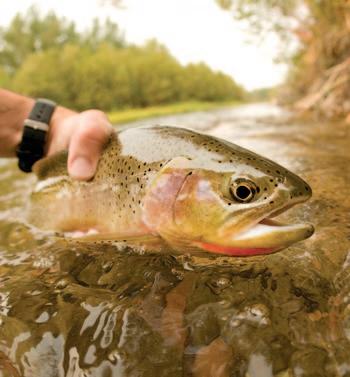
help but admire the resiliency of this native population of fish out here in central Montana that has somehow held on against multiple threats to its survival. There’s no way of knowing for sure, but Smith says cutthroat may have been living in this stream for hundreds of thousands of years or even longer. Add to that the fish’s beauty and intrinsic value, as well as the angling opportunities they provide, and it seems clear we should be giving westslope cutthroat all the help we can to prevent the species from disappearing for good.
Editor’s note: In February 2024, FWP began revising its Cutthroat Trout Conservation Strategy, updating it from the last revision in 2007. “There have been a ton of scientific advancements and technological improvements since 2007 that we need to incorporate into the new plan,” says David Schmetterling, fisheries research coordinator.
Schmetterling notes that biologists are increasingly recommending management strategies previously used only east of the Divide to westslope streams west of the Divide.
“We’re finding that rainbow trout hybridization is in many cases the number one problem facing westslope cutthroat in western Montana, as it has been east of the Divide,” he says. “And the best fix for that is to install fish movement barriers, as we’ve done in the island ranges for years now.”

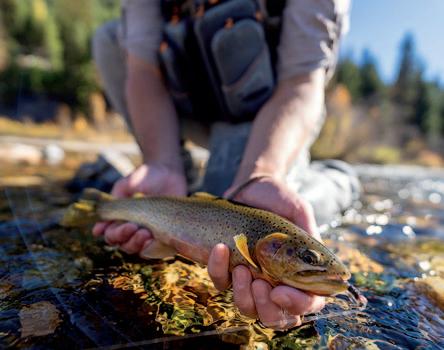
The mixed news about warming water and westslopes
For decades, the accepted wisdom among western fisheries biologists has been that westslope cutthroat need cold water to survive and that they can’t handle warmer water. It turns out that’s not entirely true.
Recent studies show that the native trout actually can thrive in water several degrees warmer than previously thought. “The main reason for the old assumption comes from confirmation bias,” says David Schmetterling, FWP fisheries research coordinator in Missoula. “The only place we see cutthroats nowadays is in mountain streams, where the water is coldest, so we assumed that’s the only habitat they can tolerate.”
Historically, westslopes swam as far downstream on the Missouri as Great Falls, and in waters like the Madison, Bitterroot, and Clark Fork, now dominated by introduced rainbows.
According to Schmetterling, the reason westslopes aren’t thriving in more rivers where they historically swam is not due to the warming climate—“They’d actually be thriving in those waters today,” he says— but from being pushed out by browns and brookies or, more commonly, hybridized with rainbows.
As well as westslopes do in warmer-thanaverage trout streams and rivers, rainbows do even better. “As rainbows thrive in this warming landscape, that is coming at the expense of cutthroats,” Schmetterling says.
The one bit of good news is that as stream temperatures continue to rise, cutthroat could prosper if their habitat can be kept safe. “In waters where we can either remove rainbows or keep them away from westslopes, we could see cutthroat doing well in the future,” Schmetterling says. n
MONTANA OUTDOORS | MARCH–APRIL 2024 | 41
CLOCKWISE FROM TOP RIGHT: PAUL N. QUENEAU; MONTANA FWP; JEREMIE HOLLMAN
NO MORE MIXING Above: Though fine sport fish, rainbow-cutthroat hybrids lack the genetic vigor of nonhybridized cutthroat trout. Below: To keep rainbows from migrating upstream and mixing with cutthroat in headwater reaches, FWP has installed fish barriers on a dozen streams east of the Divide, including this one built on the South Fork Judith River in 2005.
SO THAT’S WHERE
New Motus technology helps biologists learn where birds, small mammals, and even butterflies travel throughout the year.
By Sneed B. Collard III
Ifirst spot it from half a mile away—what looks like the TV antenna that jutted up from our family’s roof when I was a kid.
But as Montana Fish, Wildlife & Parks Motus technician John Kuntz pulls up to the structure in his pickup, I see a glinting, 30foot-tall steel pole supporting three long aerials. This modest metal structure, it turns out, is key to one of the most important wildlife research and conservation breakthroughs in decades—a technology called the Motus Wildlife Tracking System.
Motus (Latin for “movement”) was developed by the conservation organization Birds Canada in collaboration with dozens of international scientific research partners. Launched in 2013, the system allows scientists to gather critical but previously unobtainable information on the movements of birds and other wildlife species.
Traditionally, tracking animals has been time-intensive, expensive, or both. For decades, scientists have attached VHF transmitters to animals and then, using hand-held receivers that beep when the subject is nearby, spend days, weeks, or months following them on foot or in vehicles trying to learn where they go. During
the past two decades, scientists have outfitted animals with expensive transmitters that communicate via GPS satellites and allow them to follow wildlife movements with far more precision.
Unfortunately, both methods require large, bulky transmitters—like those on elk neck collars—that are too heavy for smaller animals, including most birds. Besides their high cost, some satellite tags also require researchers to recover the devices to retrieve the data. Tracking efforts often fail when an animal dies or its tracking unit is damaged or lost.
This has forced biologists wanting to gather bird movement information to capture birds and fit them with multi-colored leg or neck bands unique to each individual. They release each banded bird hoping that someone will later spot and report it and its location.
That doesn’t happen too often. Most of the reported birds are those that return to the original banding locations year after year, something that doesn’t provide information on where they’ve been in the meantime. Only occasionally do scientists get lucky enough for a banded bird to be sighted or recaptured elsewhere.
For decades, wildlife biologists despaired
of ever finding an inexpensive way to track the life cycle of birds and learn crucial information about their biology, habitats, and conservation needs.
Then came Motus.
SMALL ENOUGH FOR A BEE
Motus relies on two components: tiny radio tags affixed to birds, mammals, and other animals, and receiving stations that pick up signals from the tags as the animals move past. Biologist William Blake, formerly of the MPG Ranch in Montana’s Bitterroot Valley, is now the American Bird Conservancy’s Pacific Northwest Motus coordinator. “The way Motus works is there’s an embedded signature in each tag very similar to a Morse code that tells you exactly which bird you’re listening to,” Blake explains. “That way, you can tag thousands of birds in one area and Motus can pick them all up at the same time.”

42 | MONTANA OUTDOORS | MARCH–APRIL 2024
Missoula writer Sneed B. Collard III is a regular contributor to Montana Outdoors. His newest title, Birding for Boomers—and Everyone Else Brave Enough to Embrace the World’s Most Rewarding and Frustrating Activity, will be released by Mountaineers Books in September.
PHOTOS: SMITHSONIAN’S NATIONAL ZOO & CONSERVATION BIOLOGY INSTITUTE
PING, PING, PING Key to the Motus Wildlife Tracking System are a series of stations fitted with antennae that pick up the unique signal of each tagged bird that flies past.

THEY GO
MONTANA OUTDOORS | MARCH–APRIL 2024 | 43
MIGRATION TRACKER
A Sprague’s pipit outfitted with a Motus tag is ready for release.
Equally revolutionary is the tiny size of Motus tags, says Dr. Andy Boyce, a research ecologist with Smithsonian’s National Zoo and Conservation Biology Institute. He explains that a transmitting device placed on a bird can’t weigh more than three percent of the bird’s total weight. “That creates a major problem for the vast majority of passerines [songbirds and other perching birds] that weigh under 100 grams, because satellite tags are too big and heavy.”
Motus tags, though, can be light enough to attach to any songbird—as well as to bats and even dragonflies, butterflies, and bees.
Of course, without a way to detect them, the tags are pointless. That’s where the receiving stations come in.
DETECTION STATIONS
I follow Kuntz up a steep hill for a closer look at one of FWP’s first receiving stations—one of two the agency erected to monitor experimental sharp-tailed grouse populations in parts of western Montana. Kuntz explains that each of the three aerials on this station, located between Drummond and Helmville, points in a specific direction and can detect a sharptail’s Motus tag signals as far as 12 miles away.
Received signals pass from the antenna down through cables into a waterproof box that houses a computer circuit board—what Kuntz calls the brains of the system. From there, data are stored and periodically transmitted via cellphone networks to the Motus center of operations in Canada. In remote locations such as where we are standing, solar panels power the entire setup. But Motus stations can also be installed on buildings, telephone poles, and other locations


that have easy plug-in power options.
The Motus tracking system doesn’t work well without a lot of receiving stations. The technology was first used on a wide scale in the eastern United States, where today there are hundreds of stations. The West, meanwhile, has been working to catch up. The privately owned MPG Ranch set up more than 30 stations in and around the Bitterroot Valley. Recently, FWP has committed to building 50 stations using state marijuana tax revenue, part of which is earmarked for nongame wildlife conservation.
FWP hired Kuntz, whose background with bats, birds, and other wildlife, plus skills with construction and technology, made him ideal for the job. Kuntz built the agency’s first Motus radio receiver, the one he and I are visiting, and has been watching to see whether the technology can monitor the
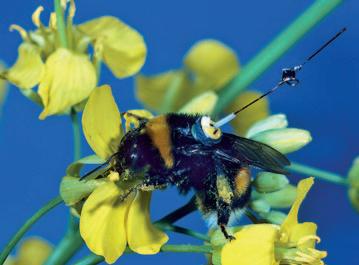
There’s an embedded signature in each tag similar to a Morse code that tells you exactly which bird you’re listening to.” “
sharp-tailed grouse recently reintroduced in western Montana (see “West Side Story,” March-April 2022 Montana Outdoors).
An even bigger priority is to create a series of Motus stations across eastern Montana. That would help fill in the vast empty regions without any Motus coverage in much of the Intermountain West. Though Idaho, Utah, and Colorado have some stations, a bird can easily follow the Central Flyway from northern Canada to Mexico without setting off a single ping in the current network.
According to Allison Begley, FWP avian conservation biologist, the department in 2024 will begin building a series of Motus stations from Butte to the North Dakota border along the Interstate 90 corridor, much of which follows the Yellowstone River. What’s being called the “Yellowstone fence” of stations will detect any bird with a Motus tag moving north or south through Montana’s eastern half and support several wildlife studies, including

44 | MONTANA OUTDOORS | MARCH–APRIL 2024
TINY TRACKERS Miniscule Motus tags are attached with glue to butterflies and bumblebees. Previously, scientists could only guess at where these and other insects flew during migration.
TAG TEAM From left to right: A crew including Megan Fylling, research director at the University of Monta

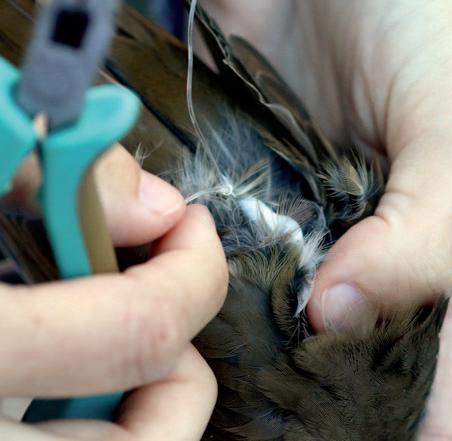
one of Montana’s top conservation priorities: grassland birds.
PRAIRIE EPICENTER
The 2022 State of the Birds report released by the U.S. North American Bird Conservation Initiative revealed that almost every group of North American birds has suffered steep declines in the past 50 years. The hardest hit have been grassland birds, whose populations have declined by one-third (34 percent) over the past 50 years. Montana is vitally important for many of these species, including the Sprague’s pipit, chestnutcollared longspur, and Baird’s sparrow.
Boyce, the Smithsonian ecologist, studies grassland bird breeding and survival in northeastern Montana. “This is the epicenter of grassland bird diversity in the United States,” he says. “The intact prairie and grasslands that we are fortunate to still have here are the stronghold for the most imperiled grassland birds in North America.”
Key to protecting these species is understanding their movements during migration and when they arrive on their Montana breeding grounds. Blake, with the American Bird Conservancy, says that federal, state, and private conservation programs protect many of those critical spring and summer habitats. “But understanding how individual birds migrate and behave outside their breeding grounds shows us other critical threats and conservation needs,” he explains. “You
Attaching the tag
A Motus tag consists of a transmitter and an antenna. To equip a songbird, scientists create a kind of “saddle,” attaching the tag to two soft, thin plastic loops cinched around the bases of the bird’s legs, with the tag sitting on its back. Batteries in bird tags can last a year or longer. Solarpowered Motus batteries extend the life of the tags even more. If a tagged bird lives long enough, the plastic loops eventually decay and the tag falls off after a year or so. Tags for bats and insects are much smaller, and are attached to the animals using glue or thread. These tags have smaller batteries that operate for only a few days or weeks. They fall off as the glue decays, or in the case of bats, when the animal’s hair grows out or is replaced. n
can’t adequately manage healthy populations if you don’t understand where individuals go for half or three-quarters of the year.”
Until recently, grassland birds have been difficult to track. They move around a lot, even during breeding season, and they hunker down out of sight in tall grass. It doesn’t help that they are the color of that grass.
“They also don’t return to the same place each year,” Boyce says. Historically, prime breeding habitat locations changed from year to year due to prairie fires, bison move-
Motus tracked a Baird’s sparrow from its release site in southwestern Saskatchewan on June 16, 2022, through Montana to a station at Fort Collins, Colorado, on August 11, 2022.

ment, or drought that altered vegetation height and composition. “Because ideal habitat for, say, a Baird’s sparrow, is shifting constantly, these birds evolved to go where the good habitat is every year.”
Motus helps track even these constantly relocating birds. Boyce and doctoral student Nancy Raginski have tagged more than 200 Sprague’s pipits and other grassland birds since 2021. In northeastern Montana, they have set up a dozen Motus stations to track the regional movements of
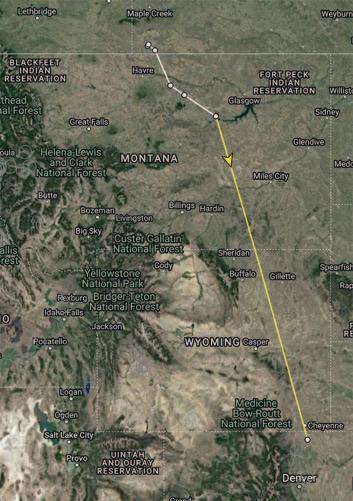
MONTANA OUTDOORS | MARCH–APRIL 2024 | 45
na Bird Ecology Lab, fits a Motus tag harness to a Wilson’s warbler and a Swainson’s thrush.
CLOCKWISE FROM TOP LEFT: SNEED COLLARD; SNEED COLLARD; SNEED COLLARD; MOTUS; DR. ANDY BOYCE; WIKIPEDIA; DAVID LAMON/MAINE AUDUB ON
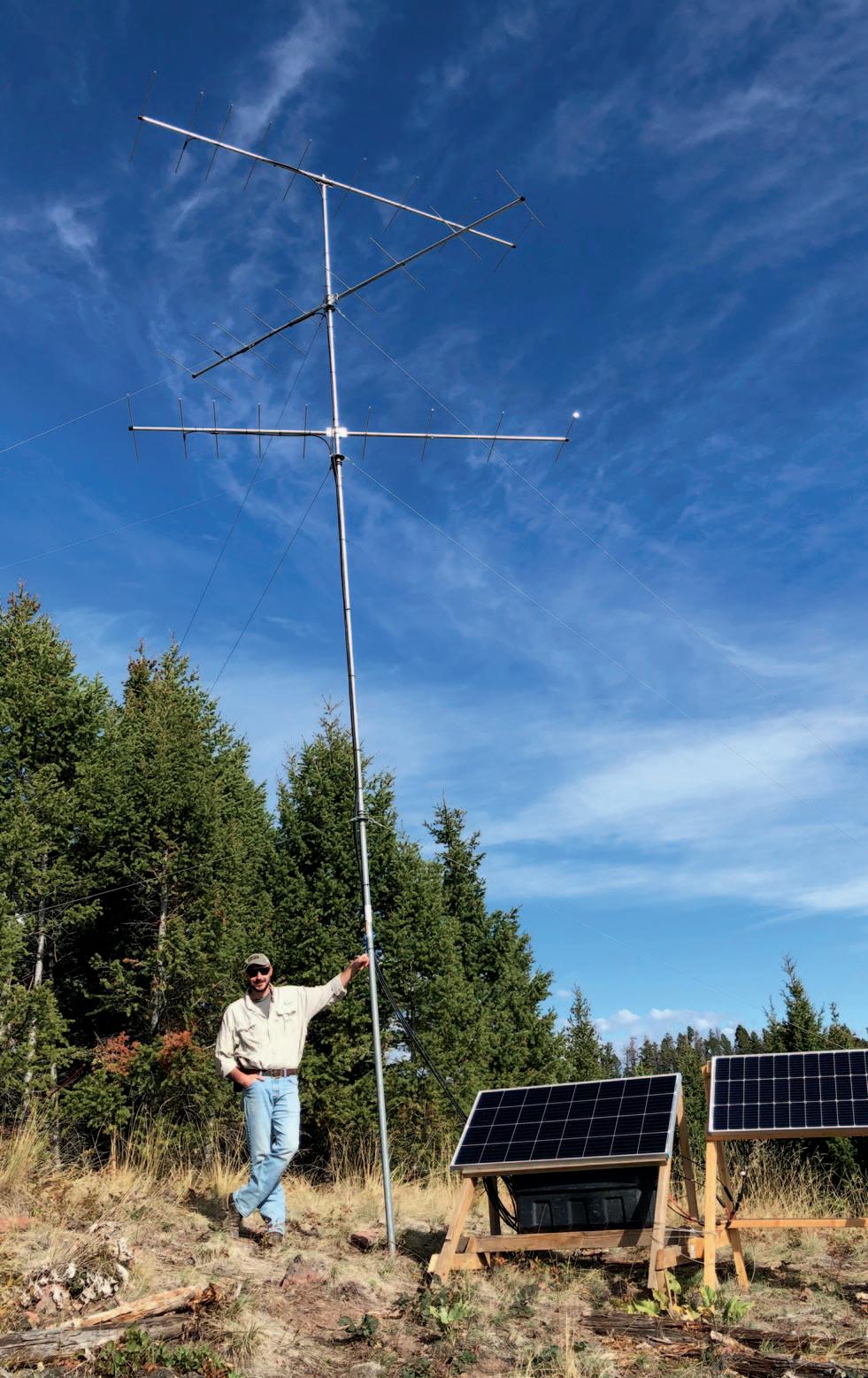
Situating the stations
A lot of work goes into installing a single Motus station, much less the more than four dozen that FWP is planning to install along the I-90 corridor from Butte to Glendive. To work correctly, each station requires line-of-sight “viewsheds” where mountains or other objects won’t interfere with signals transmitted by birds. Remote sites need enough sun exposure to power solar panels even in winter. They also need enough cellphone coverage so that data can be transmitted from the station.

This station, which FWP Motus technician John Kuntz built himself, was a challenge to situate. “There’s no cell service in this valley below us,” he says, “so I had to consider the viewshed, the cell coverage, and whether or not I could even reach it by road during various times of the year.”
After testing dozens of locations, Kuntz finally found a sliver of cell reception at the site, north of Drummond. “Thank goodness for this place, because I think that rock,” he says, pointing to a spot 10 yards below us, “is where the cell coverage drops.”
Fortunately, finding sites in eastern Montana has proved much easier. In fact, Kuntz spent most of 2023 locating dozens of potentially functional Motus sites for the Yellowstone fence and other station locations. This will greatly speed the process of installing stations in 2024. n
these birds. FWP’s planned Motus station infrastructure will vastly boost their research results and scope.
While the current stations in northeastern Montana can tell Boyce and other researchers what birds are doing during breeding season, once the birds leave they may not get detected again. The FWP Yellowstone stations, scheduled for completion in 2024, should help close that information gap. “Getting that data from the FWP stations during migration is especially important for our ability to estimate survival probability, because that’s when most birds are killed by predators, collisions with power lines, and starvation or exhaustion,” Blake says.
BRANCHING OUT
FWP biologists are now setting their sights on other species in other areas. “The next place we’re considering is the Rocky Mountain Front, to learn where aerial insectivores like swallows and nighthawks—which we don’t know much about—are moving as they travel north and south,” says Begley. Montana’s new Motus network will also be used to support research on bats, butter-
“
This is the epicenter of grassland bird diversity in the United States,” he says. “The intact prairie and grasslands still here are the stronghold for the most imperiled grassland birds in North America.”
flies, and small mammals too tiny to track with traditional means.
That expansion will benefit not only FWP scientists but also those throughout the Western Hemisphere—all of them trying to figure out what routes migrating wildlife follow and which habitats are most critical and need protection. The more stations that are added to the Motus network, the greater the benefit to the entire scientific community— and to the animals themselves.
One of the technology’s best features is
that the information it captures is available to anyone. As I was winding down my visit with Kuntz, he turned on his laptop to see if any new “hits” had been detected by a new FWP Motus station in Miles City. Kuntz told me the station had previously detected one Baird’s sparrow and one chestnut-collared longspur as the birds were beginning their migration south. “Let’s see if it has picked up anything else,” he said, logging onto the Motus website run by Birds Canada, then to the Miles City station, where he clicked on a table of detections.
“A Sprague’s pipit!” he said. “That’s one of Andy Boyce’s birds!”
Nothing could have better affirmed both the utility of Montana’s new Motus network and the wisdom of investing in it. Boyce had tagged the bird on June 7, 2023, near Zortman, and now, 107 days later, Motus indicates it’s winging its way south past Miles City. To top it off: Kuntz learned all this from a windy hilltop more than 400 miles away.
See how Motus works by visiting motus.org. Zoom in on the map and click on the station of interest to see which birds and other wildlife it has detected and when.
Following bird #37809’s journey across the Great Plains
To appreciate the power of Motus, all you have to do is look at the journeys of birds that have been tagged. Take #37809, a Sprague’s pipit equipped with a Motus tag on its breeding grounds at the American Prairie Reserve. The Smithsonian team tagged the bird on July 14, 2022, and through October 8, the pipit was detected dozens of times by the Motus stations in northeastern Montana. After October 8, #37809’s transmitter fell silent—only to show up a week later near the Kirwin National Wildlife Refuge in northern Kansas.
After that, the bird disappeared. It could have reached its wintering grounds in Mexico or the southwestern United States, beyond the reach of any other Motus stations. Or its tag could have failed. Or the bird could have been killed by a predator or exhaustion.
Six months later, however, on April 14, 2023, stations in central Kansas picked up the pipit again. Only 11 days—and 800 miles—later, it was back on its breeding grounds in northeastern Montana. All told, Motus stations detected the bird more than 140 times while its tag remained active, providing remarkable details of one Sprague’s pipit’s movements and life cycle.
As Montana’s Yellowstone Motus “fence” takes shape, and as other stations go online across the continent, scientists will get the most complete pictures yet of some of our most fascinating and imperiled bird species.
Check out #37809’s amazing journey by visiting https://motus.org/ data/track?tagDeploymentld=37809. n


MONTANA OUTDOORS | MARCH–APRIL 2024 | 47
CLOCKWISE FROM FAR LEFT: SNEED COLLARD; SNEED COLLARD; MOTUS; SHUTTERSTOCK
The ice man laugheth
By Tom Dickson
In early January, Brian Clemen, an FWP recreation technician and ice-fishing whiz in Helena, caught a 33 ¾-inch, 15.5pound walleye through the ice at Canyon Ferry. A few days later, he showed me the video of landing the massive fish and said it had received 10 million hits on social media.
That got me super excited to go out to the reservoir the following weekend. The action! The lunkers! The fame!
Then I came to and remembered what ice fishing is really like.
It’s cold, for one thing. You stand or sit on a vast slab of ice, generating almost no body heat. What little you do produce gets sucked away by the relentless wind.
Unlike, say, the natural splendor of stream or river trout fishing in summer, there’s not a lot to see on a frozen lake. After a few hours of staring at the ice hole, you might see a bird pass overhead, and that’s big excitement. Hey, a crow!
For most of us, ice fishing is not especially productive, either. On open water, your can troll a crankbait behind a boat, or stand on shore and repeatedly cast and retrieve a spinner, eventually covering miles of water where fish could be lurking.
But with ice fishing, you drill a hole, lower your bait, and wait in the off chance that a fish is down there in that one cubic meter of cold water. It’s like shooting your shotgun into the air and hoping a duck is flying by.
Innovators have devised ways to make the sport more comfortable and effective. Lightweight portable shelters block the wind. Power augers punch through thick ice in seconds, allowing anglers to drill a dozen holes in a day so they can move around and increase their odds of finding a hungry fish. Portable sonar units show if anything is swimming down there below your hole.
Keep in mind, though, that seeing fish does not convince them to bite. On a sonar screen,
Tom Dickson is the Montana Outdoors editor.
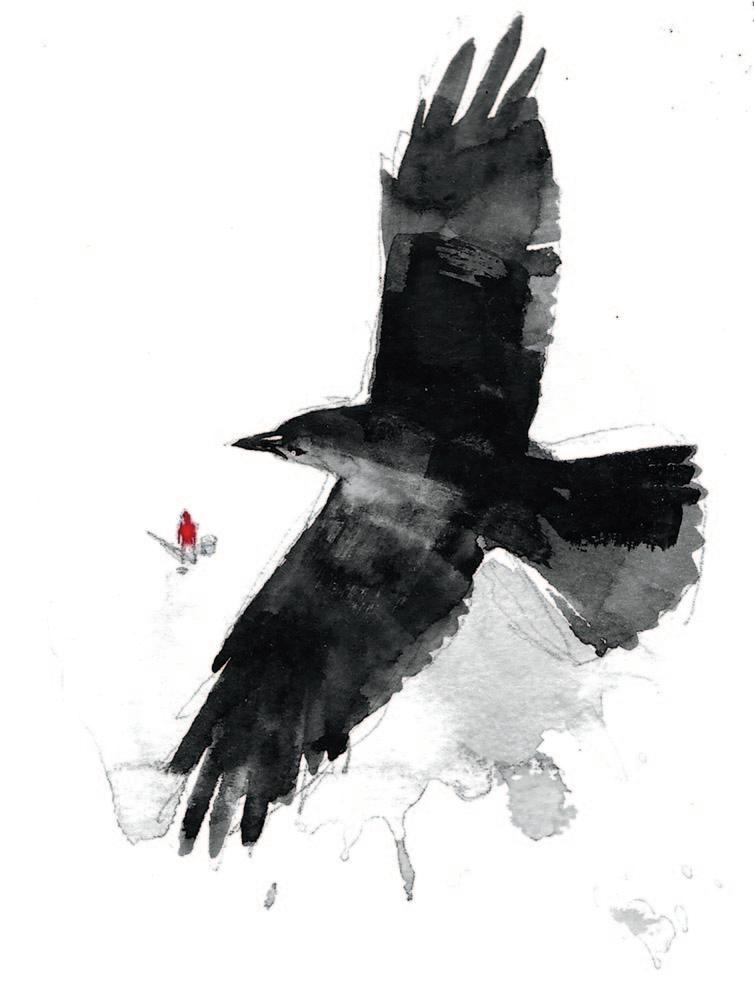
I’ve watched my bait-tipped jig wiggle amid a school of perch for 30 minutes before the fish collectively yawned and moved off.
Sure, I occasionally caught fish back when I used to partake. A few times I even went home with a limit of perch or trout. But the effort-to-results ratio over the course of a winter rarely added up. I eventually concluded that I just wasn’t that good at it or didn’t have the right temperament.
The most fun I ever had ice fishing was a few years ago when I helped with an FWP Hooked on Fishing class of grade-school kids out at the Helena Regulating Reservoir.
The instructor and I drilled a bunch of holes and got the kids set up with rods and micro jigs tipped with maggots. Then we waited. And waited. After an hour, not one kid had gotten a bite. Typical ice fishing.
The sun was dropping, and the temperature started going down with it. Just as the instructor was about to call it a day, we heard
a squeal and looked to see a girl with a fat 16inch rainbow that she’d pulled up through the ice flopping at her feet. All the other kids dropped their rods and ran over, yelling, “A fish! A fish!” while I got out my camera and had her pose for a trophy shot. But as she lifted the trout, it leaped out of her hands into the air, hung there for a full second, then dropped head-first into the ice hole and was gone.
The kids went silent, and all of us turned to look at the girl. She was staring at the hole with a stunned expression on her face. Then she started giggling. Soon the other kids joined in and we were all laughing. The only trout our group caught had miraculously gotten away.
That’s the thing about ice fishing. Yes, the auger, chair, rod, reel, jigs, and bait are definitely essentail. But considering the cold, the wind, and the lack of bites, the single most important thing you need to bring out onto the ice is a healthy sense of humor.
48 | MONTANA OUTDOORS | MARCH-APRIL 2024
ILLUSTRATION BY STAN FELLOWS
SKETCHBOOK
Black bear
Ursus americanus
By Jim Pashby
In Montana, grizzly bears get so much attention—state mammal, federal oversight, mascot for the 2023 national champion runnerup NCAA Division I football team—that a person could forget about the griz’s far more numerous and equally fascinating cousin, the black bear.
IDENTIFICATION
Black bears are Montana’s second-largest carnivore (though technically they are omnivores, eating other foods in addition to meat). As the name implies, most are black, usually with a tan muzzle. But they can also be blond, cinnamon, or brown like a grizzly.
Black bears have a slight shoulder hump, but not nearly as big as a grizzly’s, and when black bears walk on level ground, their butt sits higher than the rest of their body.
The muzzle is straight in profile, compared to the grizzly’s slightly concave snout. The ears are longer and more pointed than a grizzly’s short, rounded ears. Males weigh 170 to 480 pounds, and females 130 to 300 pounds.
REPRODUCTION
Females first breed at age 2 ½ or 3 ½, though in poor habitat they may not have their first young until age 6 ½. Breeding occurs in early summer, and the female has her one or two cubs while hibernating in winter.
HABITAT
Like coyotes, black bears can do well just about anywhere in Montana, from high mountains to prairie river bottoms. They especially like dense forests and are most abundant in northwestern Montana, though their range extends east across the state’s entire southern half. Black bears often follow stream bottoms into towns like Bozeman and Missoula, where they sometimes come dangerously close to people. The bears are lured by the smell of unsecured fruit
Jim Pashby is a writer in Helena.

SCIENTIFIC NAME
Ursus is Latin for “bear,” and americanus refers to the Americas, where the species lives.
trees, garbage, dog food, chicken coops, bird feed, and barbecue grill grease.
FOOD
In addition to human-related foods noted above, black bears will eat about anything nature offers. The omnivores dine on grasses, sedges, berries, fruits, nuts, the inner bark of trees, insects, honey, eggs, carrion, rodents, and the occasional deer or elk fawn.
MANAGEMENT
With a state population of roughly 13,000 (compared to about 1,500 grizzly bears), black bears are thriving in Montana. There are enough to allow managed spring and fall hunting seasons, which result in a
yearly harvest of about 1,000. FWP biologists have done extensive research on black bears and found that even with hunting, the population is doing well throughout the species’ range. A new study is looking more closely at populations in different regions of the state.
As with grizzly bears, conflicts between black bears and people are increasing each year as more homes are built in bear habitat. A top priority for FWP is to reduce conflicts so that people aren’t injured by bears and bears don’t have to be killed to protect human safety. The main way FWP staff do that is by convincing people to keep their garbage and other outdoor food attractants secured so bears can’t get to them.
DONALD M. JONES MONTANA OUTDOORS | MARCH–APRIL 2024 | 49 OUTDOORS PORTRAIT
THE OUTSIDE IS IN US ALL.
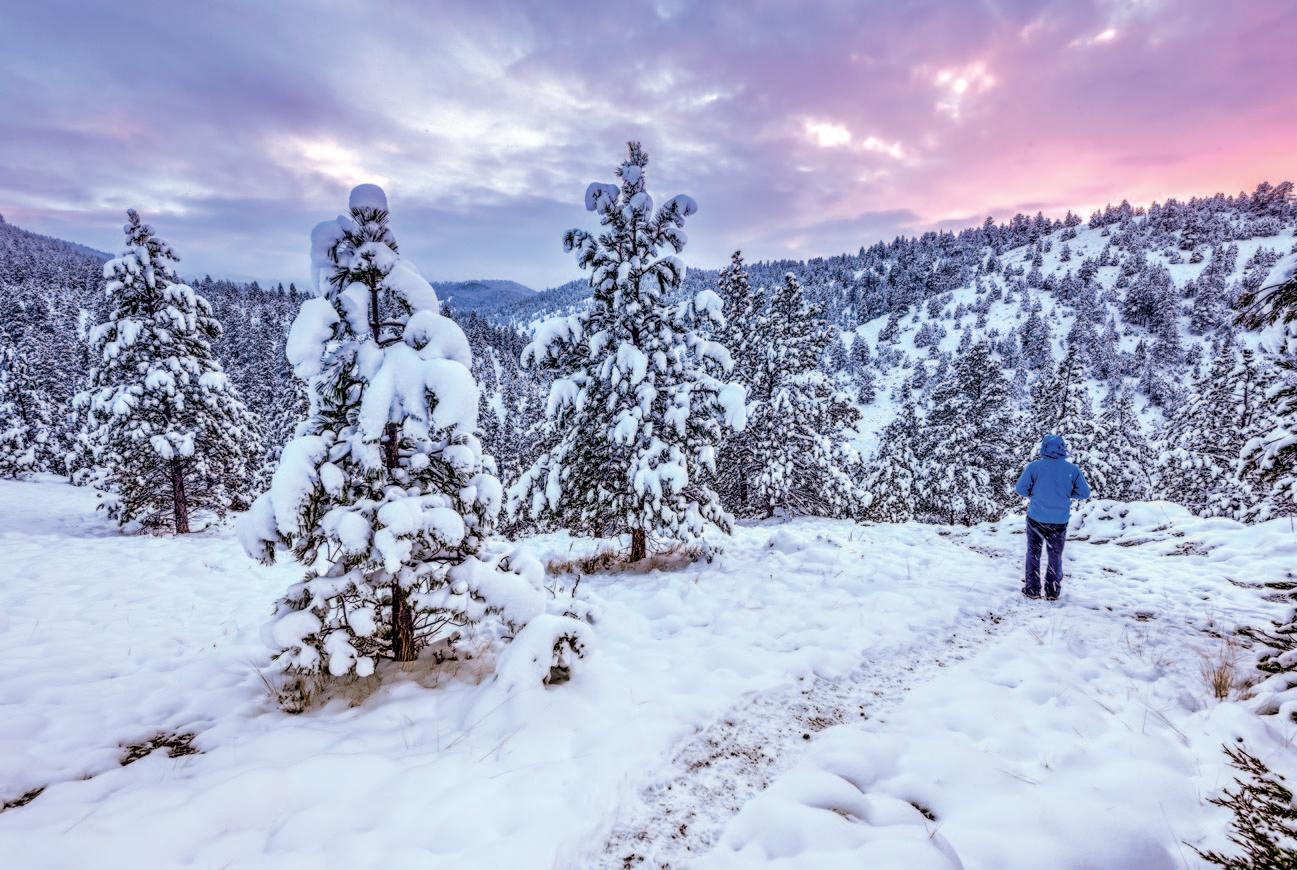
Whether it’s by boating, fishing, camping, mountain biking, hunting, wildlife watching, or hiking in Helena’s South Hills, Montana is a state where everyone can find their own special way to connect with the natural world. Around here, the outside is in us all.
PHOTO BY KEVIN LEAGUE
Online: fwp.mt.gov/montana-outdoors
Subscriptions: 800-678-6668

OUTDOORS $4.50 Montana Outdoors Magazine
MONTANA

















































 HOLTER HAUL Clockwise from above left: FWP fisheries technician Chris Hurley, FWP Fish Habitat Bureau chief Adam Strainer, and technician Ashton Mohar prepare to check survey nets at Holter Reservoir; weighing a kokanee; a big burbot (ling); sorting fish by species; walleye stomach contents (dyed with
pink preservative); pulling
crews try
return
fish
HOLTER HAUL Clockwise from above left: FWP fisheries technician Chris Hurley, FWP Fish Habitat Bureau chief Adam Strainer, and technician Ashton Mohar prepare to check survey nets at Holter Reservoir; weighing a kokanee; a big burbot (ling); sorting fish by species; walleye stomach contents (dyed with
pink preservative); pulling
crews try
return
fish



























































